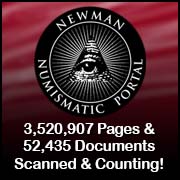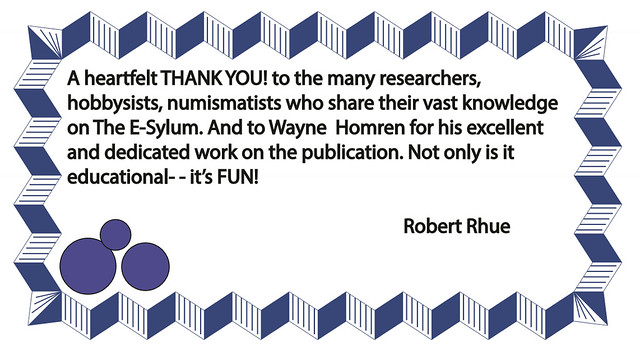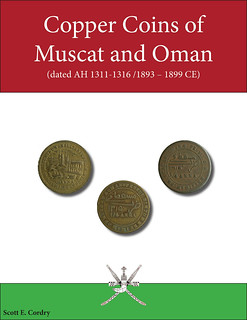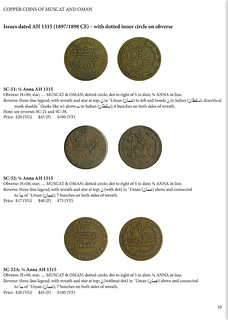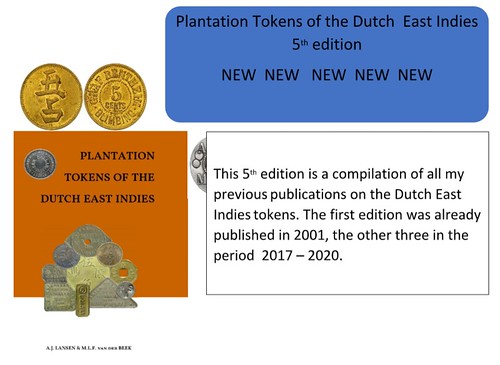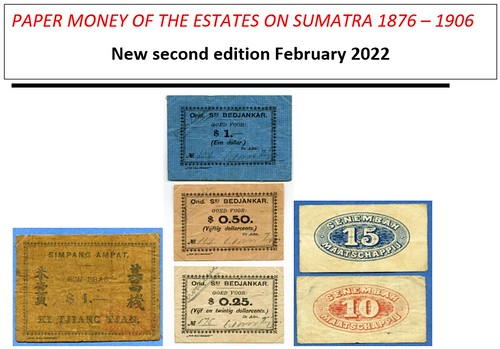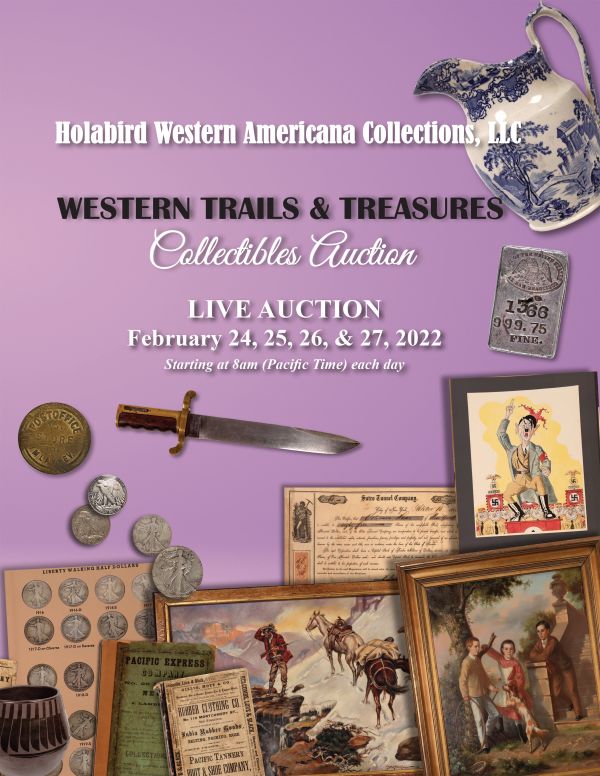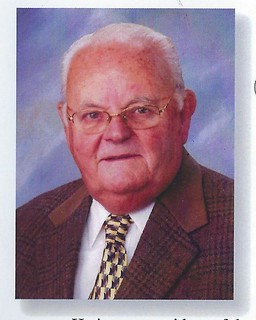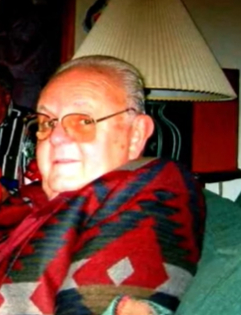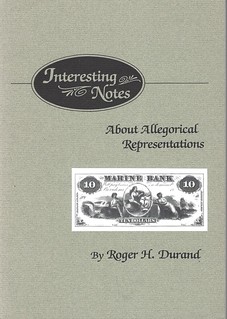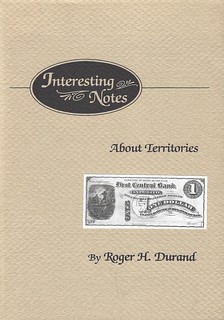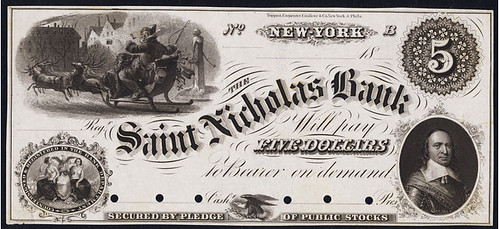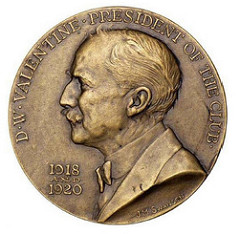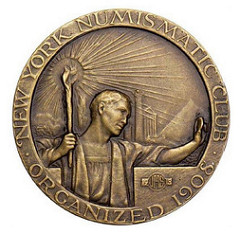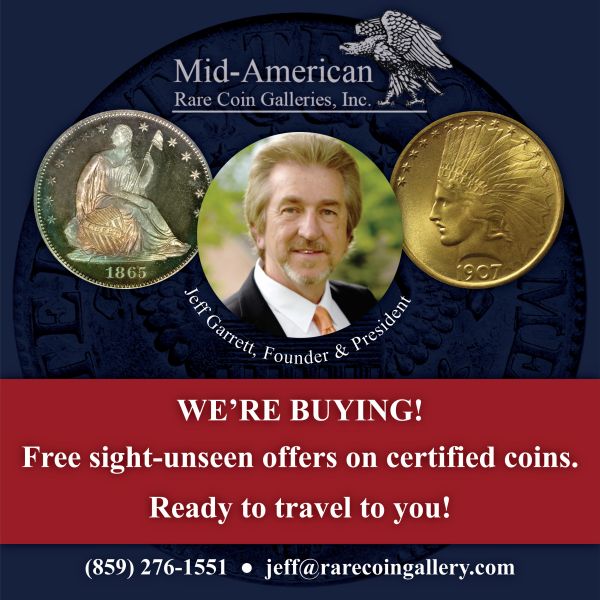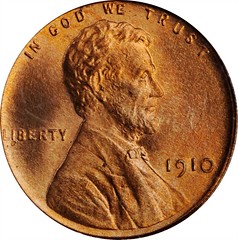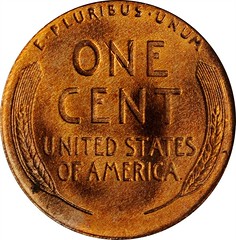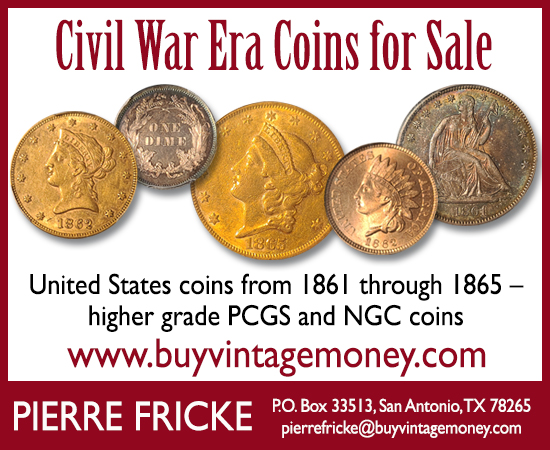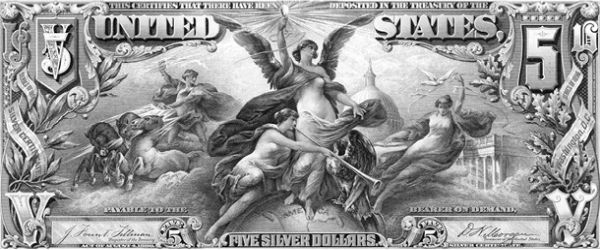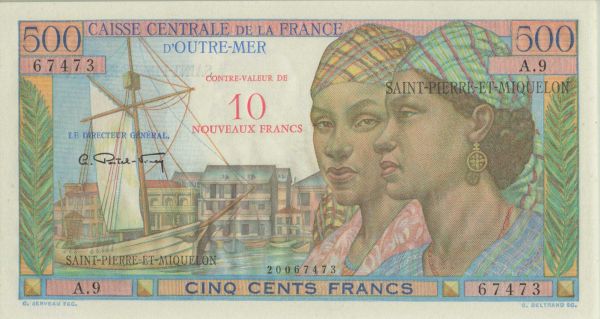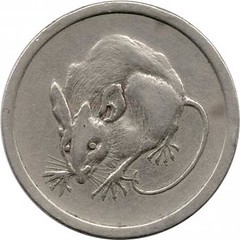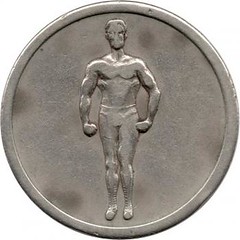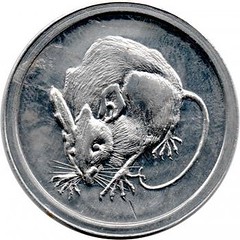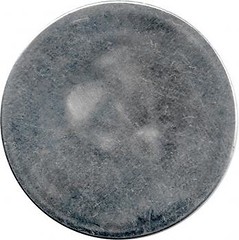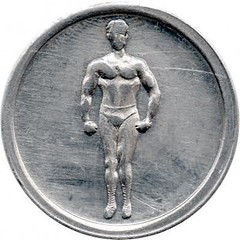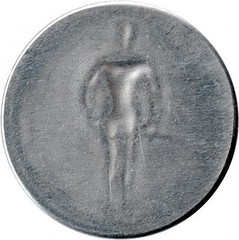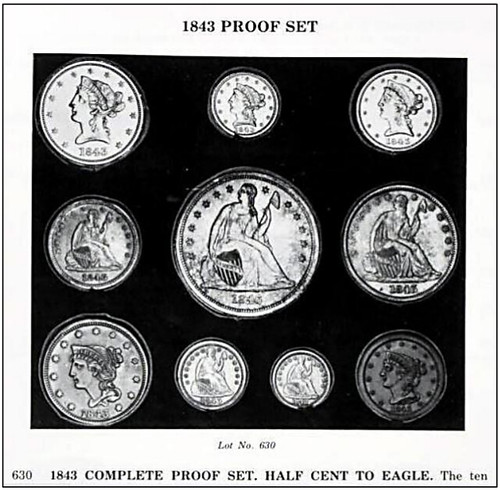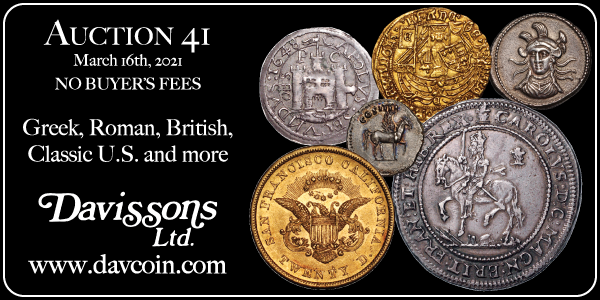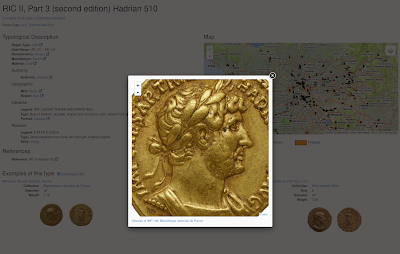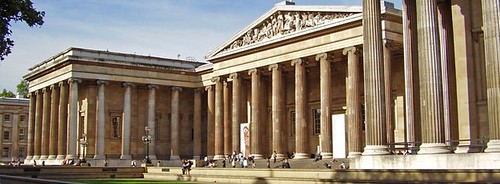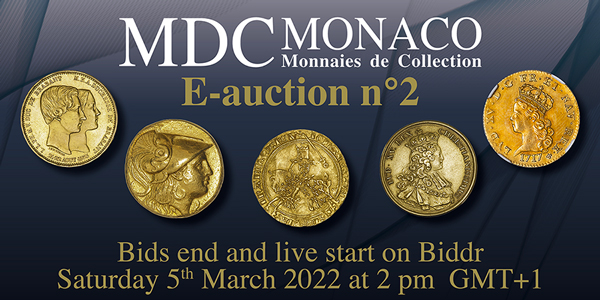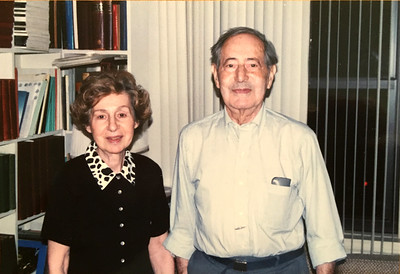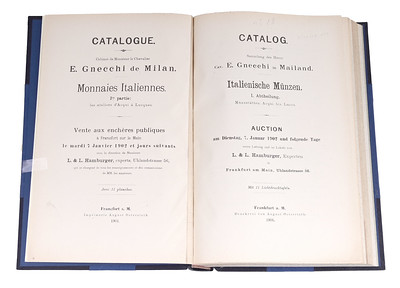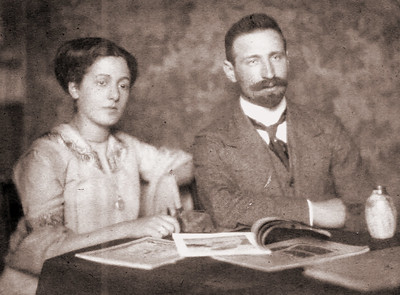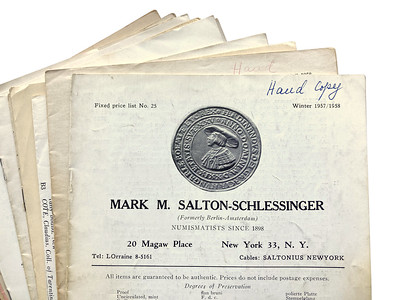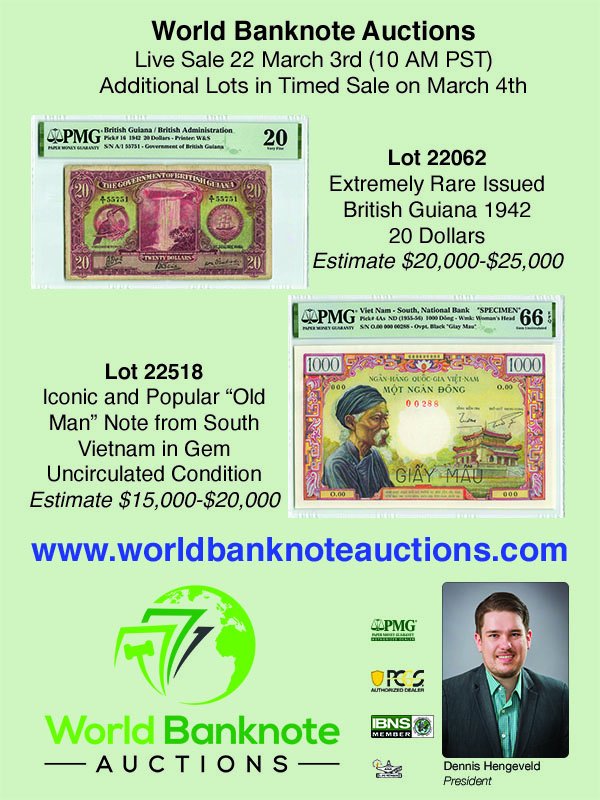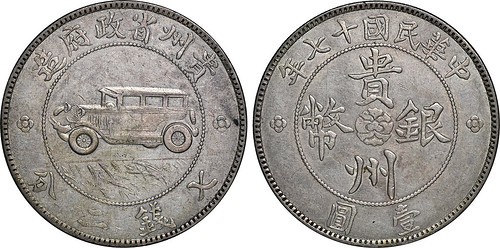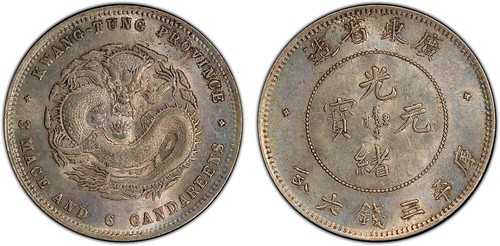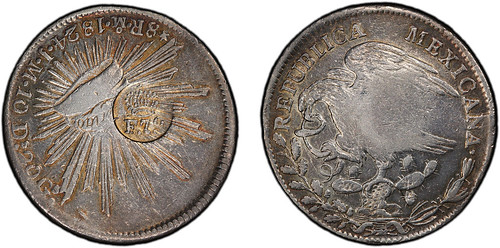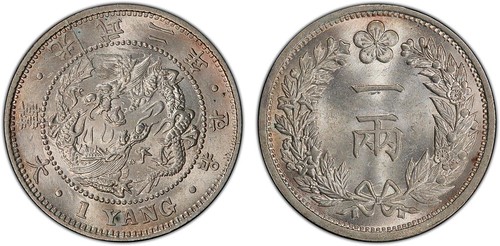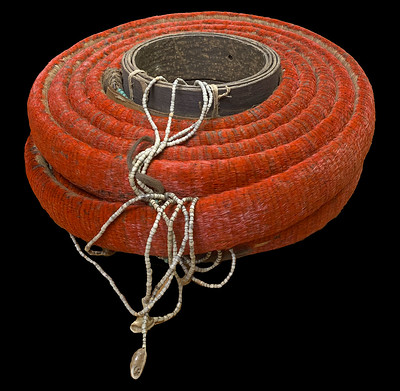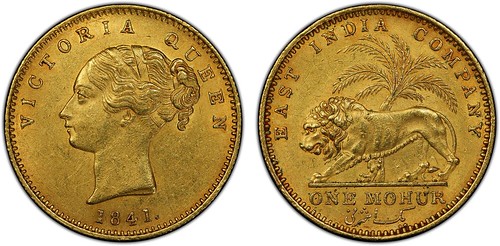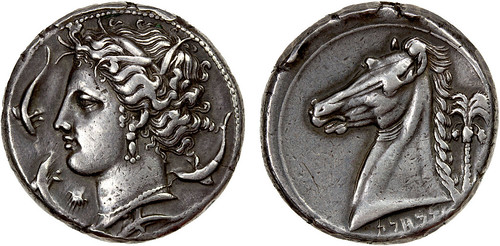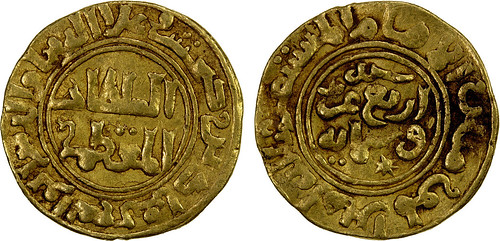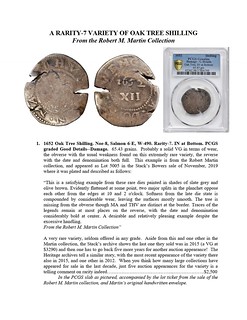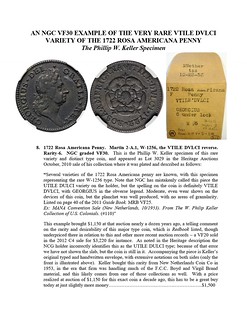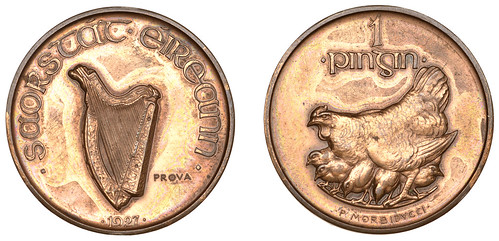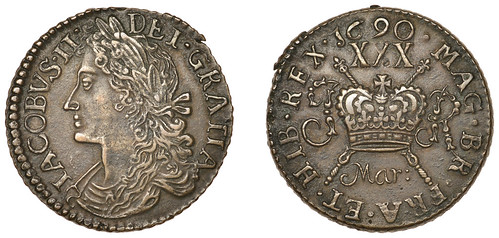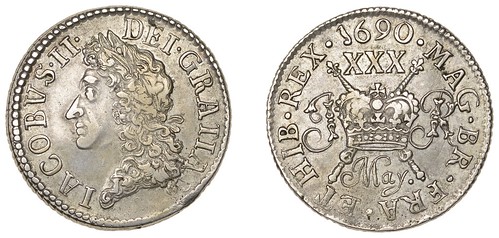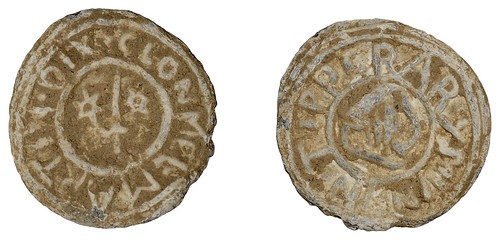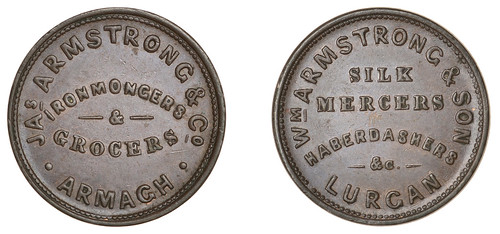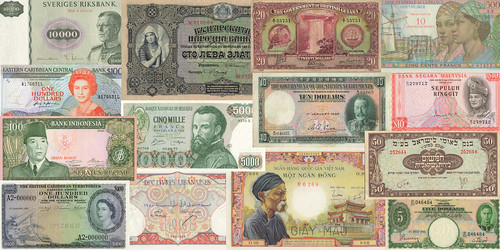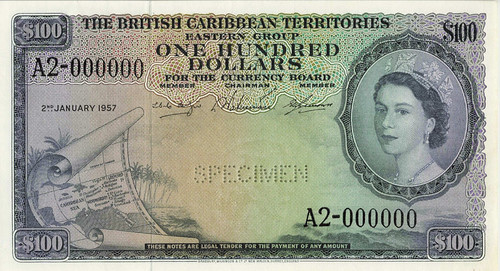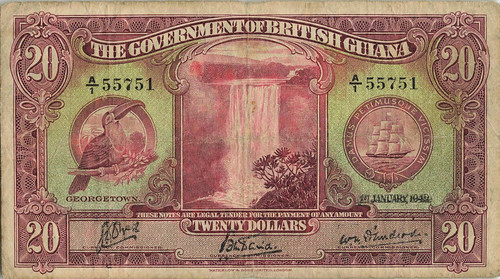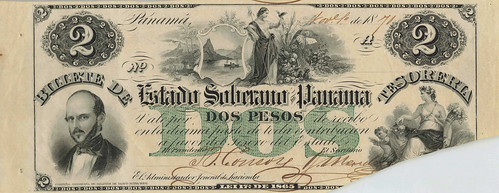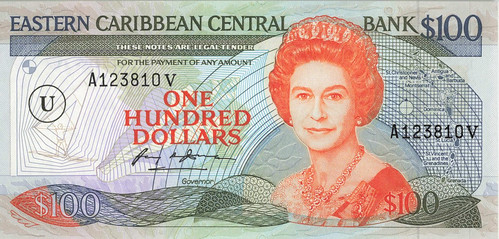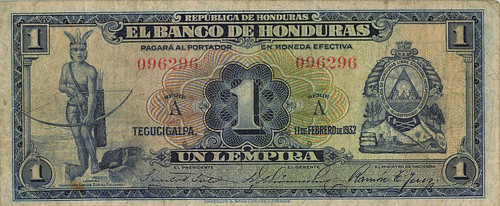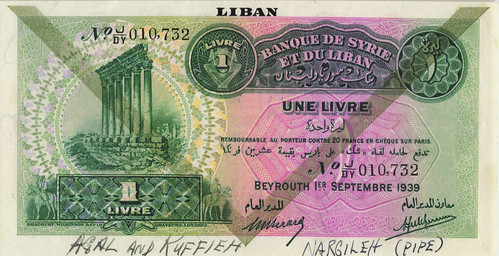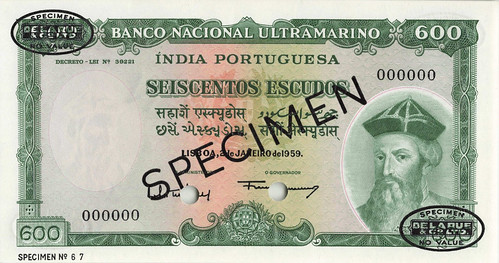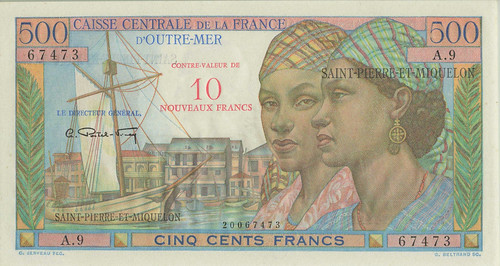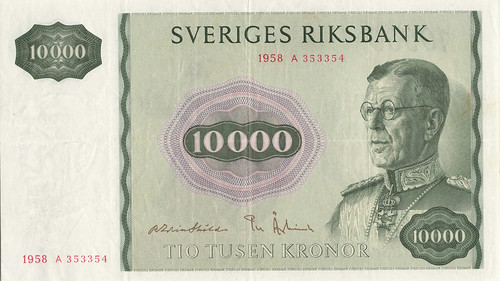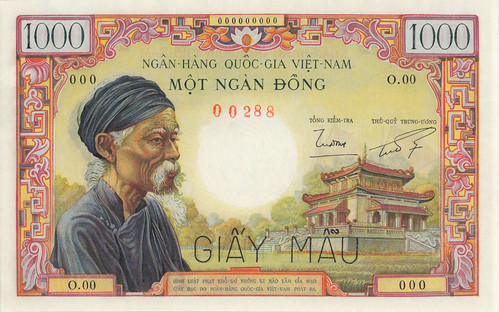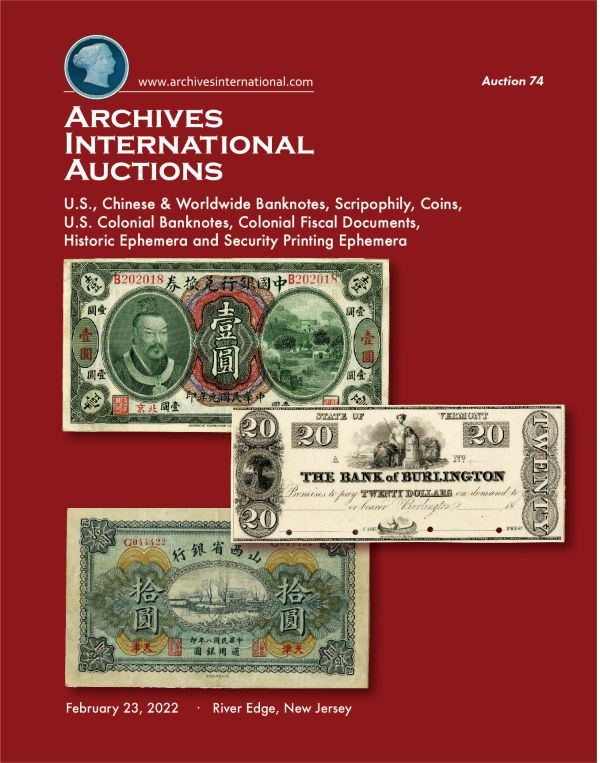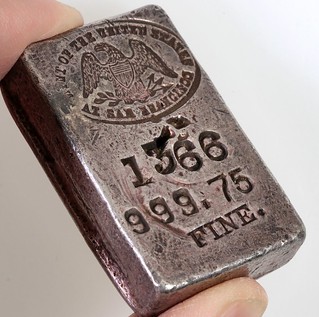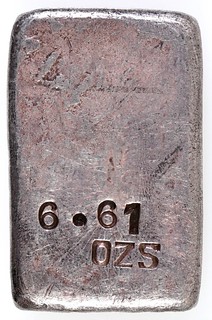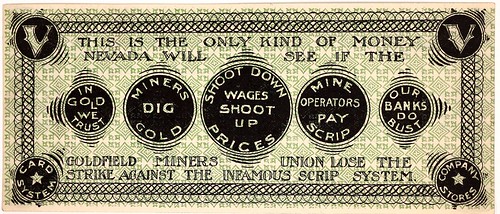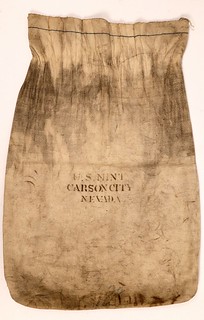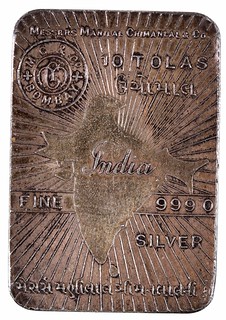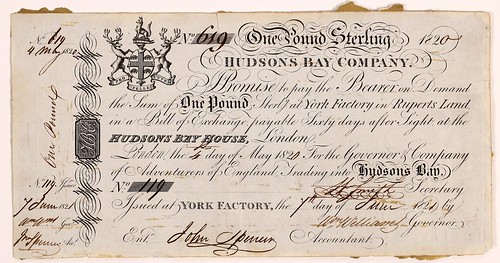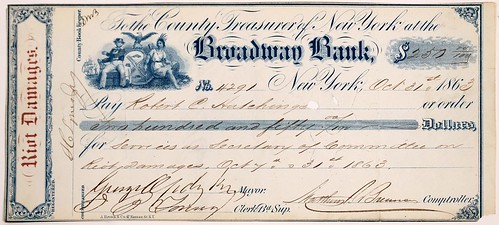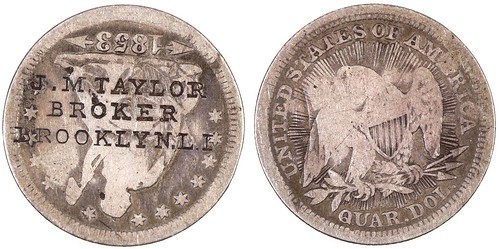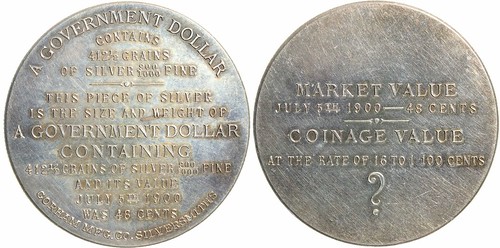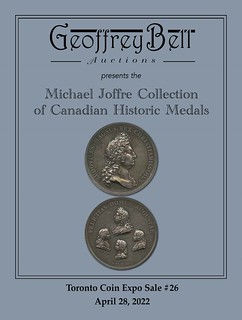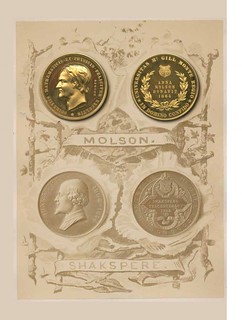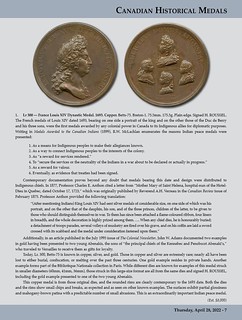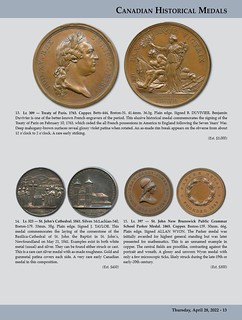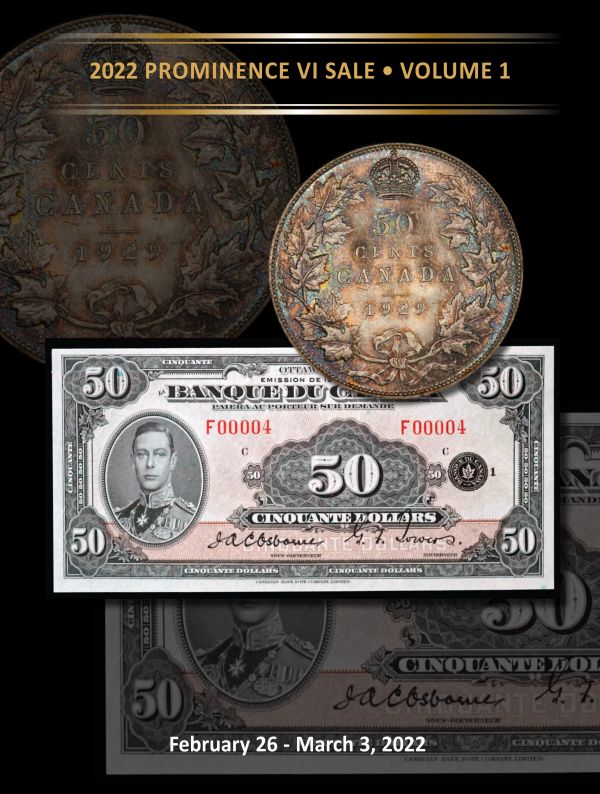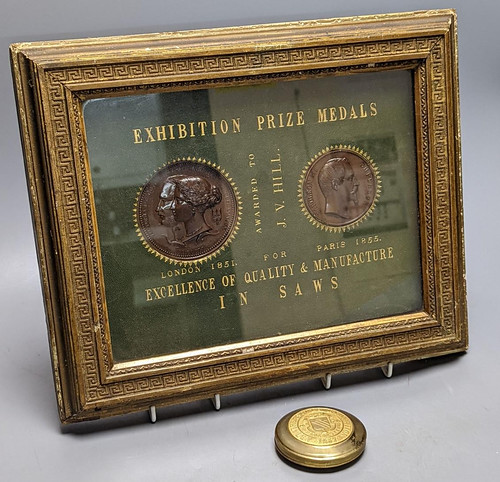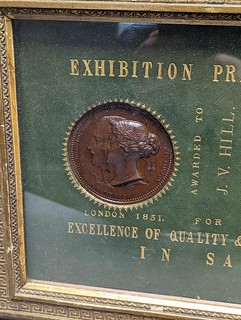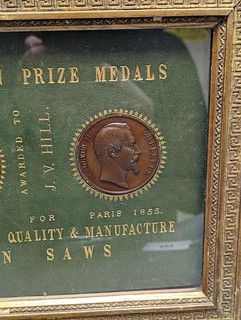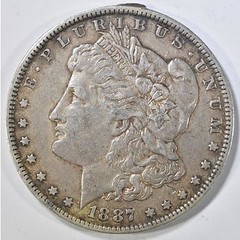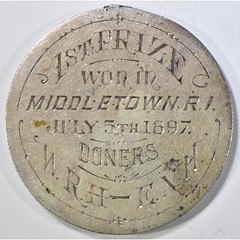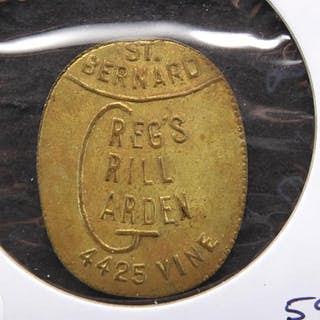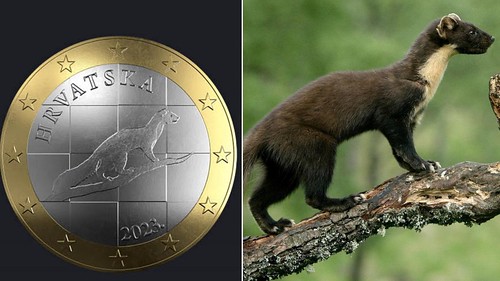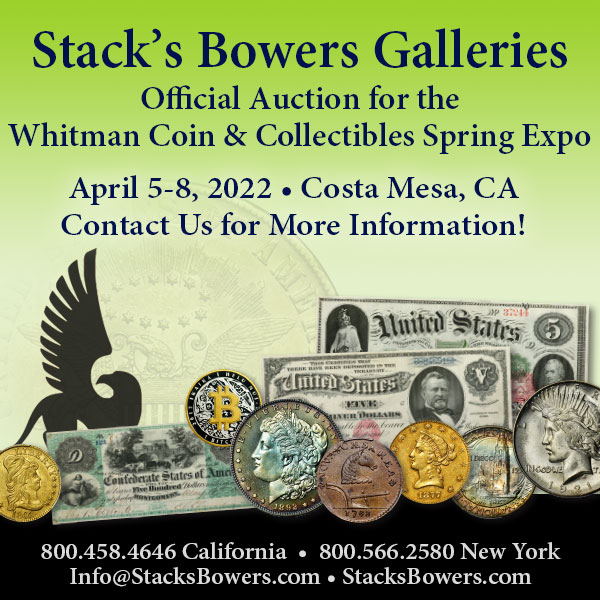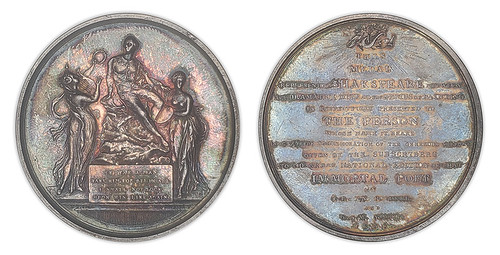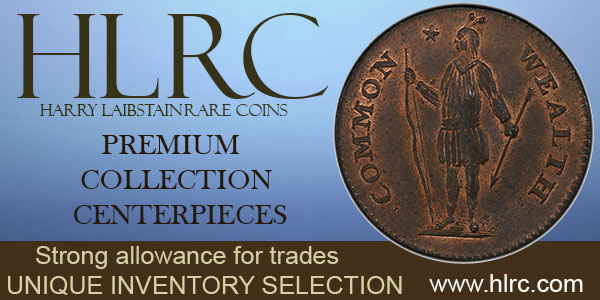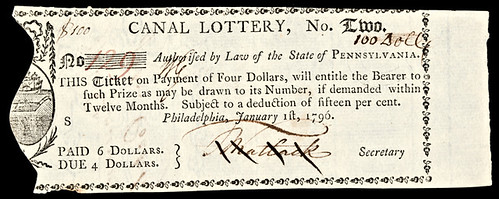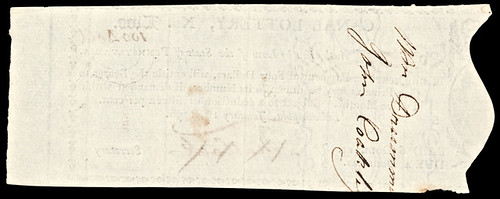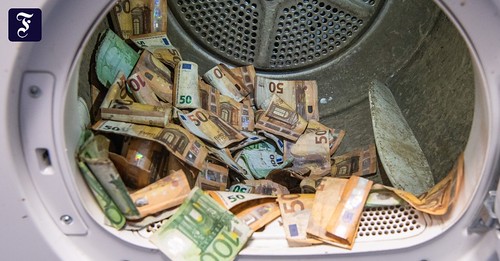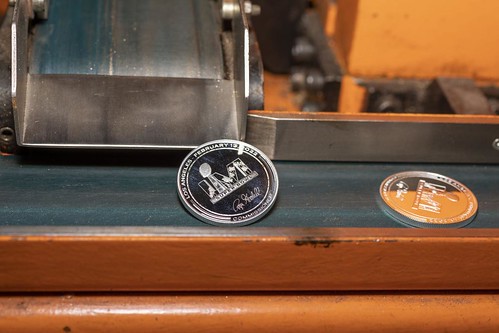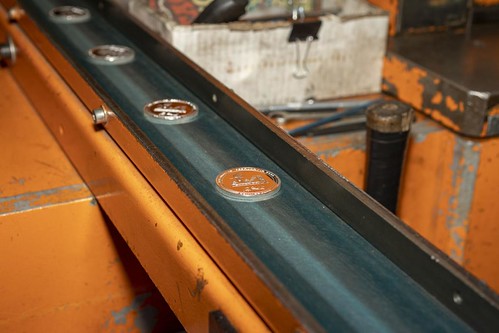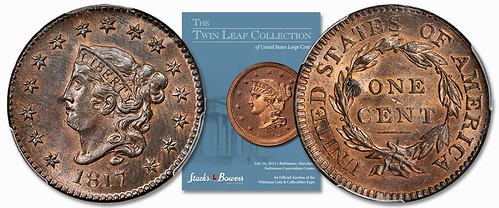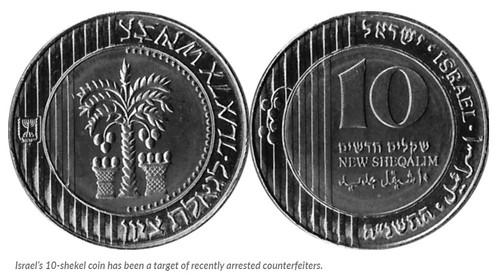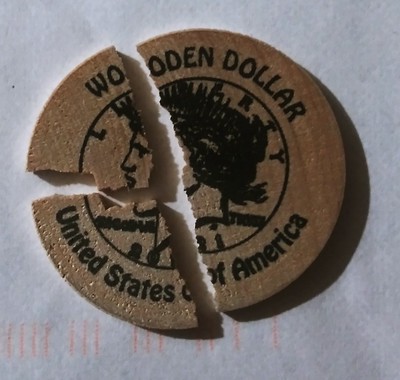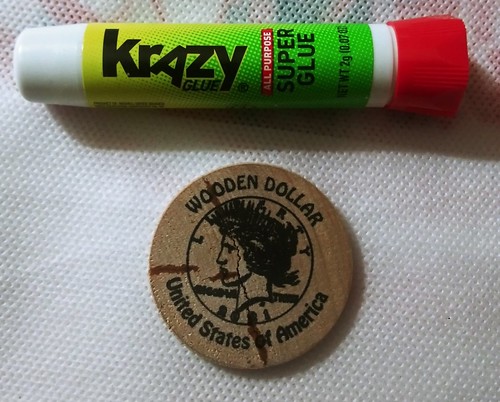
Visit our NBS Sponsors



About UsThe Numismatic Bibliomania Society is a non-profit association devoted to the study and enjoyment of numismatic literature. For more information please see our web site at coinbooks.org SubscriptionsThose wishing to become new E-Sylum subscribers (or wishing to Unsubscribe) can go to the following web page link MembershipThere is a membership application available on the web site Membership Application To join, print the application and return it with your check to the address printed on the application. Print/Digital membership is $40 to addresses in the U.S., and $60 elsewhere. A digital-only membership is available for $25. For those without web access, write to: Charles Heck, Treasurer AsylumFor Asylum mailing address changes and other membership questions, contact Chuck at this email address: treasurer@coinbooks.org SubmissionsTo submit items for publication in The E-Sylum, write to the Editor at this address: whomren@gmail.com BUY THE BOOK BEFORE THE COIN |
- WAYNE'S WORDS: THE E-SYLUM FEBRUARY 13, 2022
- KOLBE & FANNING BUY OR BID SALE NUMBER 18
- NEW BOOK: COPPER COINS OF MUSCAT & OMAN
- NEW BOOK: DUTCH EAST INDIES PLANTATION TOKENS
- NEW BOOK: SUMATRA ESTATES PAPER MONEY 2ND
- NEW JOURNAL: STUDIA NUMMORUM
- ROGER H. DURAND (1935-2022)
- THE VALENTINE MEDAL
- KIMBERLY DUMAS JOINS NEWMAN PORTAL STAFF
- VIDEO: TULSA COIN SHOW
- PENNY DRESSES AND TANGUAY PENNIES
- NOTES FROM E-SYLUM READERS: FEBRUARY 13, 2022
- ANS BURNETT CHAIR OF ROMAN NUMISMATICS
- 8,000+ ROMAN IMPERIAL COINS ADDED TO OCRE
- BRITISH MUSEUM KEEPER OF COINS AND MEDALS
- ORIGINS OF THE GERMAN COIN TRADE
- VOCABULARY TERM: HOLLOWBACK
- WHO WAS THE FIRST COIN COLLECTOR?
- DON EVERHART'S CAREER IN COINS, PART 3
- STEPHEN ALBUM RARE COINS AUCTION 42 RESULTS
- ROSA AMERICANA COLONIAL COINS PRICE LIST #22
- DIX NOONAN WEBB OFFER IRISH COINS
- WORLD BANKNOTE AUCTIONS SALE 22
- HOLABIRD FEBRUARY 2022 SALE SELECTIONS
- JOFFRE CANADIAN HISTORICAL MEDALS COLLECTION
- NUMISMATIC NUGGETS: FEBRUARY 13, 2022
- CROATIAN COIN COPYRIGHT CONTROVERSY
- SHAKESPEARE MEDAL REUNITED WITH FAMILY
- 1796 CANAL LOTTERY TICKET
- BUNDESBANK DRIES FLOOD MONEY
- HIGHLAND MINT MAKES SUPERBOWL LVI COINS
- LOOSE CHANGE: FEBRUARY 13, 2022
- GLUE AND THE ART OF NUMISMATIC REPAIRS
Click here to read the thin version on the web
Click here to subscribe
Click here to access the complete archive
To comment or submit articles, reply to whomren@gmail.com
Content presented in The E-Sylum is not necessarily researched or independently fact-checked, and views expressed do not necessarily represent those of the Numismatic Bibliomania Society.
WAYNE'S WORDS: THE E-SYLUM FEBRUARY 13, 2022
 New subscribers this week include:
Michael Ball,
Kimberly Dumas, and
Rob Luton.
Welcome aboard! We now have 6,880 subscribers.
New subscribers this week include:
Michael Ball,
Kimberly Dumas, and
Rob Luton.
Welcome aboard! We now have 6,880 subscribers.
This is another big issue, and my apologies to those who've forwarded comments and articles that didn't make it into this issue. Some will appear next week.
Thank you for reading The E-Sylum. If you enjoy it, please send me the email addresses of friends you think may enjoy it as well and I'll send them a subscription. Contact me at whomren@gmail.com anytime regarding your subscription, or questions, comments or suggestions about our content.
This week we open with a numismatic literature sale, four new books, a new journal, updates from the Newman Numismatic Portal, penny dresses, and more.
Other topics this week include the Valentine medal, Tanguay pennies, Roman Imperial coinage, Don Everhart, Roger Durand, Andrew Burnett, auction previews, colonial coins and lottery tickets, Canadian historical medals, and Superbowl coins.
To learn more about the coins of Muscat & Oman, Santa Claus notes, Daniel W. Valentine, provenance and scholarship, origins of the German coin trade, the first coin collector, feather coil money, the Free State Penny, Goldfield Miners Union Scrip, the New York City Draft Riot and Greg's Grill Garden, read on. Have a great week, everyone!
Wayne Homren
Editor, The E-Sylum
KOLBE & FANNING BUY OR BID SALE NUMBER 18
Numismatic Booksellers Kolbe & Fanning submitted this announcement of their eighteenth "Buy or Bid Sale" which closes on February 21, 2022. Good luck, everyone! -Editor
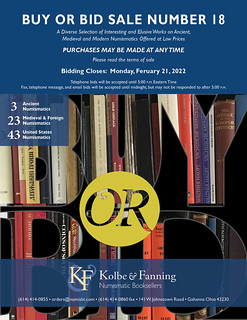 Kolbe & Fanning Numismatic Booksellers have announced our latest
Kolbe & Fanning Numismatic Booksellers have announced our latest Buy or Bid Sale,
which begins now and will close on Monday, February 21, 2022. With hundreds of new additions, the sale focuses on modestly priced books, giving collectors an opportunity to add to their libraries at minimal cost.
The sale includes over 1600 works on ancient, medieval and modern coins, as well as general works, periodicals and sale catalogues. Buy
prices have been kept low to promote sales. To further encourage participation, the firm is offering free domestic shipping to bidders spending at least $300; there is also no packing and processing fee for this sale. Again, please read the Terms of Sale before participating.
As the name of the sale suggests, customers may bid on items they wish to acquire or buy them outright at the published price. The Terms of Sale will give full instructions on how to participate: please read it carefully.
There is no printed catalogue. The PDF catalogue is available now for downloading from the Kolbe & Fanning website at numislit.com. Please send all bids to orders@numislit.com or use the bid sheet included at the end of the PDF catalogue.
To read the complete catalog, see:
https://www.numislit.com/images/upload/kolbefanningbob18.pdf
NEW BOOK: COPPER COINS OF MUSCAT & OMAN
Mahdi Bseiso submitted this announcement of a new book on the coins of Muscat & Oman. Thanks. -Editor
I would like to share the news of a book that I just published. The original research is by Scott Cordry, the introduction by Dr. Wolfgang Schuster, and put together and published by me (ArabianCoins). I believe that the Esylum Digest would be a great way to share this with interested numismatists.
The book is a detailed, illustrated guide to the numerous varieties of the 1/12 Anna and 1/4 Anna copper coins of Muscat & Oman dated AH 1311-1316 (1893 – 1899 CE). This is the first illustrated, in-depth work providing a historical context for these coins, and cataloging dozens of varieties that are only superficially covered in standard references, if at all.
28 x 22 cm, colored soft cover, 50 pages, weight 300g.
ISBN: 978-1639-44-793-0
For more information, or to order, see:
Book: Copper Coins of Muscat & Oman dated AH1311-1316 / 1893-1899 CE (New 2022)
(https://www.ebay.com/itm/255372226593)
Book: Copper Coins of Muscat & Oman dated AH 1311-1316 / 1893-1899 CE
(http://arabiancoins.com/product/copper-coins-muscat-oman-1311-1316/)
NEW BOOK: DUTCH EAST INDIES PLANTATION TOKENS
The 5th edition of Adrian Lansen's book on plantation tokens of the Dutch East Indies has been published. -Editor
This new 5th edition lists 362 tokens with description, including one new Estate: Bajoelor, 8 new discovered tokens, 50 tokens provided with new data and 7 new token images. A detailed description is also given of the estates and companies that issued these tokens.
Each token is identified by its denomination, shape, size, weight, metal composition and die axis position. Insofar as possible, an colour illustration has been provided. The catalogue is in English and has an introduction in English and Dutch.
Hard Bound copy – 179 pages – Format A4
PRICE : 32.50 Euro, postage excluded.
ORDER BY @ : a.j.lansen @hccnet.nl or lansenkil@hotmail.nl
or by post: A.J. Lansen - Haanderik 94 - 3401 ET IJsselstein The Netherlands
PAYMENT : by bank account or PayPal
To read the earlier E-Sylum article, see:
NEW BOOK: DUTCH EAST INDIES PLANTATION TOKENS
(https://www.coinbooks.org/v23/esylum_v23n12a05.html)
NEW BOOK: SUMATRA ESTATES PAPER MONEY 2ND
Adrian Lansen has published a new edition of his book on the paper money of the estates of Sumatra. Here's the announcement. -Editor
Now available a new, revised, publication about the paper money used on the estates on Sumatra in the period 1876 – 1906. This second revised edition includes new additional information. A full detailed description is given of 16, mainly tobacco, companies, which issued 88 different notes. These notes are described in detail and all are illustrated in colour. The publication is completely bilingual English-Dutch, with transcriptions of the headings on the notes in Chinese, Malay and Tamil.
This new book, full colour, has 132 pages in A 4 format, with hard cover, is self-published and can be ordered from the author: A.J. Lansen, Haanderik 94, 3401 ET IJsselstein ( Netherlands )
Price: 32.50 Euro + postage. Payment by PayPal or bank account.
@ mail:
a.j.lansen@hccnet.nl or
lansenkil@hotmail.nl
To read the earlier E-Sylum article, see:
NEW BOOK: PAPER MONEY OF ESTATES OF SUMATRA
(https://www.coinbooks.org/v24/esylum_v24n11a04.html)
NEW JOURNAL: STUDIA NUMMORUM
Roma Numismatics is offering a new online journal. Here's the announcement. -Editor
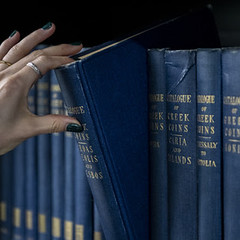 Today we are pleased to announce the inauguration of Studia Nummorum, a new online journal for the publication of numismatic studies and research which can be found on Roma Numismatics' website. Studia Nummorum has been developed as a facility to enable all researchers to have their work published for the immediate and cost-free benefit of all: as a free-to-access service published on an ad-hoc basis there are no deadlines and no wait times for publication.
Today we are pleased to announce the inauguration of Studia Nummorum, a new online journal for the publication of numismatic studies and research which can be found on Roma Numismatics' website. Studia Nummorum has been developed as a facility to enable all researchers to have their work published for the immediate and cost-free benefit of all: as a free-to-access service published on an ad-hoc basis there are no deadlines and no wait times for publication.
It is our hope that all students and researchers of numismatics, whether actively engaged in either academia or private collecting, will benefit from the leading-edge research and information that will be permanently archived at Studia Nummorum.
Studia Nummorum will partner with the University of Warwick's classics department to bring you articles from the heart of academia, in addition to the work of independent scholars and those with a passionate interest in numismatics.
Our inaugural publication will be 'An Unusual Hoard of Hyperpyra of John III (1222-1256)' – the last work of the esteemed late Simon Bendall and a fascinating paper discussing a Byzantine hoard from Kosovo, all of which will be offered at auction in one of our forthcoming auctions.
Studia Nummorum can be found under the 'e-journals' title, an option listed under the 'Resources' tab on our website.
For more information, see:
https://www.romanumismatics.com/ejournal
ROGER H. DURAND (1935-2022)
Numismatic researcher and author Roger H. Durand has passed. John Ferreri of NENA submitted these notes. -Editor
The New England Numismatic Association is sad to announce the passing of member Roger H. Durand, collector and author of U.S. Obsolete Currency books. He was predeceased by his second wife, Cheryl. He is survived by his first wife, Claire and his daughter Karen and three sons, Roger, Jr, Timothy and Christopher.
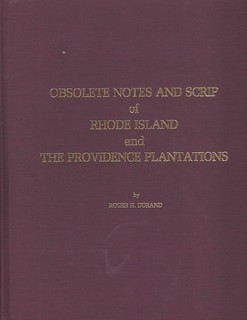 Roger's interest in collecting had its roots in Rhode Island where he started collecting coins and Civil War Tokens. His interests changed about 1970 and he became interested in paper money, especially the obsolete type from the State of Rhode Island. Roger shared what he learned from his hobby with others by writing about it. His first book, The Obsolete Banknotes of Rhode Island and the Providence Plantations is considered the bible of Rhode Island paper money. He also published a series of thirteen books following the theme, Interesting Notes about Interesting Bank Notes. Then, in 2011 he published the profusely illustrated 85 large page book, The Fabulous Roger H. Durand Santa Claus Notes Collection.
Roger's interest in collecting had its roots in Rhode Island where he started collecting coins and Civil War Tokens. His interests changed about 1970 and he became interested in paper money, especially the obsolete type from the State of Rhode Island. Roger shared what he learned from his hobby with others by writing about it. His first book, The Obsolete Banknotes of Rhode Island and the Providence Plantations is considered the bible of Rhode Island paper money. He also published a series of thirteen books following the theme, Interesting Notes about Interesting Bank Notes. Then, in 2011 he published the profusely illustrated 85 large page book, The Fabulous Roger H. Durand Santa Claus Notes Collection.
Roger served the collecting community as an officer in the various local clubs he belonged to and when regional and national clubs beckoned, he also served in various capacities there also. He was a past president of the Society of Paper Money Collectors, a past president of the Currency Club of New England, a past president of the Western Rhode Island Coin and Stamp Association and past president of the Pawtucket Numismatic Society.
Roger's involvement in the hobby led to many awards. He received the SPMC First Literary Award and two Awards of Merit. He also received the Numismatic Ambassador Award at that time given by Krause Publications. Roger's influence was felt throughout the hobby!
John & Nancy Wilson write:
"Roger's great Santa Claus collection was sold by Heritage auction company some years back and we were able to add two important notes to our collection from that sale. If our nickname is mrmrsclaus Roger's would be mrclausSr. He spent a few nights at our house some years ago and came along with us to a Whitman Show at the Cobb Galleria Center. The show had an auction that was held which had notes we needed. He was as knowledgeable as anyone when it came to obsolete notes and helped us at times with our collection. We were very sad to hear of his passing and he will be missed greatly by not only us but the many friends he had in the Numismatic hobby. Rest In Peace Roger and we send our prayers and thoughts to your family."
Pete Smith provided some additional biographical information. -Editor
Roger H. Durand was born in Central Falls, Providence County, Rhode Island, on March 24, 1935. His parents were Harold and Elsie Beck Durand. He worked for the John Hancock Insurance Co. and owned the Durand Insurance Agency in Central Falls, Rhode Island. He served with the Rhode Island National Guard. He was married twice with a daughter and three sons.
Durand's collection of Santa Claus notes was sold by Heritage Currency Auctions on January 5, 2012, lots 15689 through 15723.
He died on February 3, 2022, in Miriam Hospital in Providence.
Thanks, everyone. I didn't know Roger but greatly appreciated his books. I have a new set of his Interesting Notes series and I consult them frequently. The illustrated books are in my library. -Editor
To read his online obituary, see:
Roger H. Durand
(https://www.bellowsfuneralchapel.com/obituary/Roger-Durand)
THE VALENTINE MEDAL
Newman Numismatic Portal Project Coordinator Len Augsburger provided this summary of material relating to the portrait medal of author Daniel W. Valentine. Thanks. -Editor
The Valentine Medal
This medal is not for Valentine's Day, but rather for the New York Numismatic Club (NYNC) president Daniel W. Valentine. Valentine (1863-1932) served as the NYNC president from 1918 to 1920. He is best known today for his works on half dime varieties (published in the American Numismatic Society's Numismatic Notes and Monographs series in 1931) in addition to the volume Fractional Currency of the United States (1924). The NYNC presidential medal series is a popular one, with the Dr. Jay Galst collection representing the most significant assemblage offered in recent memory.
The model for the Valentine medal was approved at the December 9, 1921 NYNC meeting, where subscriptions for the medal were invited. The club produced eight pieces in silver and 50 in copper. Pete Smith's excellent Portrait Medals of American Numismatists, 1867-2020 notes a recent sale in silver at $1,560, while a bronze example fetched $780. An important exhibit related to this medal was presented by Jerry Fochtman at the 2013 ANA convention, who also spoke on the subject at the 2018 ANA spring convention.
Images: New York Numismatic Club presidential medal for Daniel W. Valentine
Link to Portrait Medals of American Numismatists, 1867-2020 on Newman Portal:
https://nnp.wustl.edu/library/book/599832
Link to Daniel W. Valentine publications on Newman Portal:
https://nnp.wustl.edu/library/booksbyauthor/1950
Link to Dr. Daniel Valentine: A Numismatic Pioneer (video), Jerry Fochtman presenting:
https://nnp.wustl.edu/library/book/587436
KIMBERLY DUMAS JOINS NEWMAN PORTAL STAFF
Newman Numismatic Portal Project Coordinator Len Augsburger also provided the following update. Thanks. -Editor
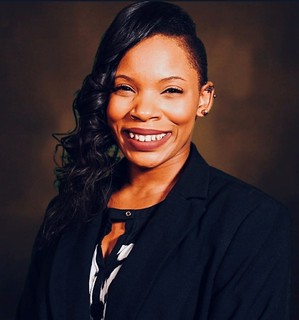 Newman Portal welcomes new staff member Kimberly Dumas, who joins the NNP project at Washington University in St. Louis as Library Technical Assistant. She holds a BA in History from the University of Houston and recently graduated from the University of Illinois (Champaign) with an MA in Library Science.
Newman Portal welcomes new staff member Kimberly Dumas, who joins the NNP project at Washington University in St. Louis as Library Technical Assistant. She holds a BA in History from the University of Houston and recently graduated from the University of Illinois (Champaign) with an MA in Library Science.
Dumas will manage the scanning queues in St. Louis, coordinating material, student staff, scanning equipment, and a host of other tasks. She has already made her first addition to the site, a run of Trade Token Topics from 1971-1982. Welcome, Kim!
VIDEO: TULSA COIN SHOW
These are selections from the David Lisot Video Library that feature news and personalities from the world of coin collecting. David has been attending coin conventions since 1972 and began videotaping in 1985. The Newman Numismatic Portal now lists all David's videos on their website at:
https://nnp.wustl.edu/library/multimediadetail/522852
Here's one on Tulsa Coin Show. -Editor
Oklahoma Numismatic Association President Chris Harrell Talks About Why Come to Tulsa Coin Show.
VIDEO: 4:37.
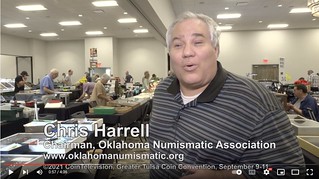 Chris Harrell, President, Oklahoma Numismatic Association,
Chris Harrell, President, Oklahoma Numismatic Association,
David Lisot, Interviewer, CoinTelevision.com. September 9-11, 2021.
Two times a year Oklahoma becomes a destination spot for coin dealers and collectors. The Oklahoma Numismatic Association hosts their annual coin conventions as part of their ongoing efforts to promote coin collecting. Find out from ONA President Chris Harrell what is involved.
David adds:
"Folks might want to tune in to the coin show in Oklahoma. The Oklahoma Numismatic Association put on a great coin convention. Listen to convention chairman Chris Harrell explain why."
An excerpt of the video is available for viewing on the Coin Television YouTube Channel at:
https://youtu.be/C_m1Q14D3-E
PENNY DRESSES AND TANGUAY PENNIES
Wayne Pearson writes:
"I liked the dress of 2000 cents. Pretty cool."
Agreed. But in the nothing-new-under-the-sun department, Julia Casey reports that the penny dress has been tried at least once before - in 1910! Very, very cool - thanks! -Editor
The recent article about the "Dress Made From Pennies" reminded me of Eva Tanguay. Tanguay is a favorite of Dave Bowers and I spent some time with him researching her for his blog. Dave wrote of Eva:
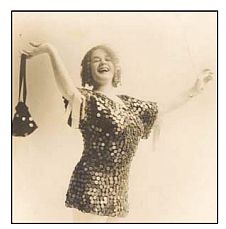 "She earned a footnote in the annals of numismatics in 1910 when she appeared on stage in a coat entirely covered with the relatively new coins. Audiences went wild when she threw handfuls of coins from the stage. One account stated that 10,000 coins were ordered by her from the Philadelphia Mint and were first tossed in Altoona, Pennsylvania, in 1910. Newspapers picked up the story, leading a man in Chicago to advertise
"She earned a footnote in the annals of numismatics in 1910 when she appeared on stage in a coat entirely covered with the relatively new coins. Audiences went wild when she threw handfuls of coins from the stage. One account stated that 10,000 coins were ordered by her from the Philadelphia Mint and were first tossed in Altoona, Pennsylvania, in 1910. Newspapers picked up the story, leading a man in Chicago to advertise Tanguay pennies
for five cents each in groups of five or more."
A description of Eva's personal items located in the collection of the Wistariahurst Museum (Holyoke, Massachusetts) includes an image of her in her coin-garment.
Here's an excerpt from Dave's 2020 article. The outfit weighed 65 pounds! -Editor
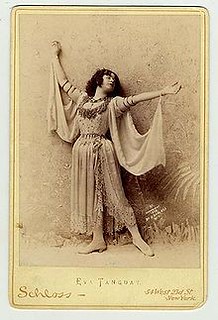 Perhaps the most famous distributor (if that is the right word) of Lincoln pennies was Eva Tanguay, the most famous vaudeville star of the day. Born in Canada in 1878, she moved with her family to Holyoke, Massachusetts, when she was six years old. On stage at Parsons Hall in an amateur night show when she was eight, Eva appeared in character as a young girl, but in the unusual garb of wearing several knit chair throws and fabric from an old umbrella. From the outset, she was different and unusual. Two years later she toured professionally with a troupe showcasing scenes from a popular novel, Little Lord Fauntleroy. In 1901 she was on stage in the Broadway musical My Lady, followed in 1904 by The Chaperons in the same venue. By 1905 she was in a solo vaudeville act that drew wide attention. One success led to another, and by 1910 she was earning as much as $3,500 per week (equivalent to close to $100,000 today).
Perhaps the most famous distributor (if that is the right word) of Lincoln pennies was Eva Tanguay, the most famous vaudeville star of the day. Born in Canada in 1878, she moved with her family to Holyoke, Massachusetts, when she was six years old. On stage at Parsons Hall in an amateur night show when she was eight, Eva appeared in character as a young girl, but in the unusual garb of wearing several knit chair throws and fabric from an old umbrella. From the outset, she was different and unusual. Two years later she toured professionally with a troupe showcasing scenes from a popular novel, Little Lord Fauntleroy. In 1901 she was on stage in the Broadway musical My Lady, followed in 1904 by The Chaperons in the same venue. By 1905 she was in a solo vaudeville act that drew wide attention. One success led to another, and by 1910 she was earning as much as $3,500 per week (equivalent to close to $100,000 today).
She earned a footnote in the annals of numismatics in 1910 when she appeared on stage in a coat entirely covered with the relatively new coins. Audiences went wild when she threw handfuls of coins from the stage. One account stated that 10,000 coins were ordered by her from the Philadelphia Mint and were first tossed in Altoona, Pennsylvania, in 1910. Newspapers picked up the story, leading a man in Chicago to advertise Tanguay pennies
for five cents each in groups of five or more.
To read the complete article, see:
Bowers on collecting: Lincoln pennies galore!
(https://mintnewsblog.com/bowers-on-collecting-lincoln-pennies-galore/)
For more on the Tanguay archive, see:
Holyoke Collection:
Eva Tanguay, 1878 - 1947
(https://wistariahurst.org/wp-content/uploads/2016/04/Eva-Tanguay-Collection.pdf)
To read the earlier E-Sylum article, see:
THE DRESS MADE FROM PENNIES
(https://www.coinbooks.org/v25/esylum_v25n06a30.html)
NOTES FROM E-SYLUM READERS: FEBRUARY 13, 2022
On Provenance and Scholarship
Bill Eckberg writes:
"Ron Guth's project to identify Eliasberg coins and reunite them with their provenance is most interesting and, at least to me, important. Those of us for whom provenance and scholarship are significant seem to be in the minority in numismatics these days.
"It is not surprising that important coins from such collections have been separated from their provenances. I have no doubt that gradeflation and greed are the two overlapping reasons. Everybody knows that 65 is a higher number than 63, right? So, obviously any MS65 coin must be better than any MS63. Why would an auction house admit that their magnificent MS65 gem was once considered a lowly MS63? More money is to be made off a gem UNC than a mere choice UNC, even when they are the exact same piece.
"It's sad that numismatics has become an industry more than a hobby, and the number on the little piece of paper in the plastic is more important than that round, metal thing packaged with it."
To read the earlier E-Sylum article, see:
REDISCOVERING ELIASBERG'S CONTINENTAL DOLLAR
(https://www.coinbooks.org/v25/esylum_v25n06a12.html)
Editor Reaches Numismatic Pinnacle
When a reader last week mentioned that I hadn't included the grade in an item about a Confederate banknote, I wrote:
Peter Huntoon writes:
"With your reply you lofted yourself to a numismatic pinnacle in my eyes!"
Well, thanks. We of course have nothing against third-party grading, it's just that we generally avoid topics of grade and price in The E-Sylum to focus instead on the history behind numismatics, to include art, economics, politics and personalities. Like Bill Eckberg, we prefer provenance and scholarship.
And when we illustrate numismatic items we generally crop out slabs and grades. People can always go to the excerpted article or auction lot to see those - we just prefer pictures of coins over pictures of slabs. One example is the press release for World Banknote Auctions elsewhere in this issue. Rather than show side-by-side images of slabbed notes (where the notes themselves appear small), we show one side of each note full screen. These are beautiful artworks, and something is lost when they're reduced in size.
Which leads me to a related topic and a pet idea of mine, which I think the recent Van Gogh Immersive Experience illustrates well. The beautiful artwork of numismatics deserves a similar treatment. Walking into a coin show should be an equally immersive experience - imagine billboard-sized projections of high resolution photos of coins and paper money. Wouldn't that be a marvelous first impression and a lasting memory? -Editor
To read the earlier E-Sylum article, see:
NOTES FROM E-SYLUM READERS: FEBRUARY 6, 2022 : How High Exactly?
(https://www.coinbooks.org/v25/esylum_v25n06a09.html)
More on the Man-or-Mouse Tokens
Regarding the "Are you a man or a mouse" flipper token,
Richard Greever writes:
"There are a couple pieces on the TokenCatalog site, and two Anillo restrikes.
"I believe these are the same dies as the brass piece illustrated. These are believed to be related to the Eddie Cantor "Strike Me Pink" tokens. But this was already figured out."
Thanks! Here are the images and links. -Editor
To read the complete item description, see:
http://tokencatalog.com/token_record_forms.php?action=DisplayTokenRecord
&td_id=457905&inventory_id=487974&td_image_id=458158&attribution_id
=470909&record_offset=1
To read the complete item description, see:
http://tokencatalog.com/token_record_forms.php?action=DisplayTokenRecord
&td_id=457906&inventory_id=581471&td_image_id=396678&attribution_id
=470911&record_offset=0
To read the complete item description, see:
http://tokencatalog.com/token_record_forms.php?
action=DisplayTokenRecord&td_id=457907
To read the earlier E-Sylum article, see:
MYSTERY ANSWER: ARE YOU A MAN OR A MOUSE?
(https://www.coinbooks.org/v25/esylum_v25n06a08.html)
The Value of Double Eagles
Peter Jones writes:
"Dave Bower's new book on quarter eagles reminds me of a quote I believe once came from him, that 75% of the value of all US coins ever minted were double eagles from 1849 to 1933. It still amazes me how Dave can write so many books and keep doing so."
To read the earlier E-Sylum article, see:
IN APPRECIATION OF QUARTER EAGLE GOLD COINS
(https://www.coinbooks.org/v25/esylum_v25n06a02.html)
More on the Fernand David Collection
Herman Blanton writes:
"The last two E-Sylums mentioned the Fernand David collection with reference to the upcoming Gadoury auction this coming March 12, 2022. I have had an interest in the collection for many years but agree with other writers that information about the collector is hard to come by. I made a slide presentation last year at our local coin club. Today I assembled the slides into a pdf for those interested in the collection. If you follow the slides for lot 112 you will find an interesting turn."
Very interesting - recommended reading. -Editor
To read the slide presentation, see:
Fernand David Collection
(http://macuquina.com/articles/schulman_19300311_hb_commentary.pdf)
To read the earlier E-Sylum articles, see:
GADOURY ANNOUNCES FERNAND DAVID SALE
(https://www.coinbooks.org/v25/esylum_v25n05a22.html)
NOTES FROM E-SYLUM READERS: FEBRUARY 6, 2022 : Answer: Gadoury Chronograms Spotted
(https://www.coinbooks.org/v25/esylum_v25n06a09.html)
ANS BURNETT CHAIR OF ROMAN NUMISMATICS
The ANS has endowed a new chair of Roman Numismatics. Here's the press release. -Editor
The American Numismatic Society (ANS) is pleased to announce the establishment of the Andrew M. Burnett Chair of Roman Numismatics.
The newly endowed chair is named in honor of renowned numismatist, scholar, and ANS Board of Trustees Vice President Andrew M. Burnett and is funded by an anonymous donor.
The endowment for the Chair of Roman Numismatics will allow the ANS to strengthen its long-term commitment to the study and digitization of one of the largest and most important collections of ancient Roman coins in the world, ranging from the early Republican to the later Imperial and Provincial issues, and including the coins of the Byzantine period. The Burnett Chair Curator will oversee the continuing development of the critical online resources Coinage of the Roman Republic Online (numismatics.org/crro), Coin Hoards of the Roman Republic (numismatics.org/chrr), The Roman Republican Die Project (numismatics.org/rrdp), and Online Coins of the Roman Empire (numismatics.org/ocre), for which the ANS has received substantial development support from the National Endowment for the Humanities.
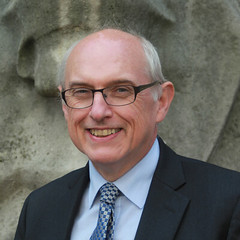 Dr. Andrew M. Burnett, of London, UK, has specialized on Roman coinage since he
joined the British Museum in 1974. He later became Keeper of Coins and Medals,
and subsequently Deputy Director of the Museum. He has been the President of the
Royal Numismatic Society, the Society for the Promotion of Roman Studies, and the
International Numismatic Commission. Dr. Burnett has been an Honorary Professor
of University College, London, and is currently Chair of the Royal Mint Museum. An
ANS Member since 1982, he was Visiting Scholar in 1982, and was elected to the
Board of Trustees in 2013, serving as Second Vice President of the Society since
2017.
Dr. Andrew M. Burnett, of London, UK, has specialized on Roman coinage since he
joined the British Museum in 1974. He later became Keeper of Coins and Medals,
and subsequently Deputy Director of the Museum. He has been the President of the
Royal Numismatic Society, the Society for the Promotion of Roman Studies, and the
International Numismatic Commission. Dr. Burnett has been an Honorary Professor
of University College, London, and is currently Chair of the Royal Mint Museum. An
ANS Member since 1982, he was Visiting Scholar in 1982, and was elected to the
Board of Trustees in 2013, serving as Second Vice President of the Society since
2017.
Dr. Burnett received his BA and MA from the University of Oxford, and his PhD from the University of London. He is author, co-author, or editor of more than 25 books and more than 100 articles and book reviews. They include Coinage in the Roman World (1987) and the Roman Provincial Coinage series (1992, ongoing). He also has an interest in the history of numismatics, co-authoring Sir Thomas Smith's On the Wages of the Roman Footsoldier (ANS, 2017), and recently publishing The Hidden Treasures of this Happy Island: A History of Numismatics in Britain from the Renaissance to the Enlightenment (2020). He has been honored by the Royal Numismatic Society, the Belgian Numismatic Society, the French Numismatic Society, and in 2007 he received the ANS's Archer M. Huntington Award for excellence in Numismatic Scholarship, the Society's highest honor. He is a Fellow of the British Academy, and in 2012 was appointed Commander of the British Empire (CBE) by the Queen for services to the British Museum and to numismatics.
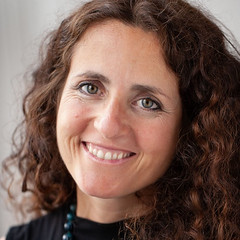 Dr. Lucia Carbone, Assistant Curator of Roman Coins and the scientific co-director
of the Roman Republican Die Project, will be the first ANS curator to hold this
endowed chair. Dr. Carbone first joined the Society in 2016, after receiving her PhD
in Classical Studies at Columbia University.
Dr. Lucia Carbone, Assistant Curator of Roman Coins and the scientific co-director
of the Roman Republican Die Project, will be the first ANS curator to hold this
endowed chair. Dr. Carbone first joined the Society in 2016, after receiving her PhD
in Classical Studies at Columbia University.
Through her publications she has established herself as an expert in early Provincial coinage, with a specific focus on the Province of Asia (modern Turkey). Her first monograph, published in 2020, is entitled Hidden Power. Late Cistophoric Production and the Organization of Provincia Asia (128–89 BC), and deals with the impact of Roman dominion on the pre-existing monetary system of the province. Her forthcoming book, Coinage in the Roman Provinces before RPC. The R.B.Witschonke Collection, will offer insight into the complexities of Roman monetary and economic policy in the Mediterranean from the 2nd century BCE on.
An adjunct professor at Columbia University, Dr. Carbone has taught Roman numismatics, Latin, Greek, Roman history, and contemporary civilization at both college and high school levels. She is also a member of the Executive Committee of the Board of Trustees of La Scuola d'Italia, an Italian international school based in Manhattan, and actively cooperates with the Italian consulate regarding the Didactic of Ancient and Modern Languages in the US.
The ANS is deeply appreciative of the anonymous donor who chose not only to
endow this important position at the Society and allow us to further the study of our
magnificent collection of Roman coins, but also to name the endowment in honor of
a truly great scholar, our Second Vice President Andrew M. Burnett,
says ANS
Executive Director Gilles Bransbourg. And we are doubly pleased that Dr. Carbone,
a highly regarded and prominent scholar in this field, will be able to carry on and
build on Dr. Burnett's work, and, through projects like the Roman Republican Die
Project, will enhance the ANS's position at the forefront of digital humanities in the
numismatic field.
To read the complete article, see:
Press Release: Andrew M. Burnett Chair of Roman Numismatics
(http://numismatics.org/pr-burnett-chair/)
THE BOOK BAZARRE
8,000+ ROMAN IMPERIAL COINS ADDED TO OCRE
A large batch of Roman Imperial Coins has been added to the OCRE database. -Editor
More than 8,000 Roman Imperial coins from the Bibliothèque nationale de France have been integrated into Online Coins of the Roman Empire. This is a significant addition to the project, but does not represent the fully body of the BnF's material. The import includes the issues from Augustus to Trajan, a portion of the Hadrianic collection, and later coins from Carus to Diocletian.
This represents the BnF's first contribution to OCRE after providing large amounts of Roman Republican and Hellenistic coinage and a modest number of British Iron Age coinage to Iron Age Coins in Britain. Presently, the Bibliothèque nationale has made nearly 40,000 coins available in the numismatic Linked Open Data cloud.
To read the complete article, see:
More than 8,000 Roman Imperial Coins from the BnF added to OCRE
(https://numishare.blogspot.com/2022/01/more-than-8000-roman-imperial-coins.html)
BRITISH MUSEUM KEEPER OF COINS AND MEDALS
There's a position opening for Keeper of Coins and Medals at the British Museum, one of the most important coin departments in the world. Here's how to apply. -Editor
The British Museum is looking to appoint an outstanding researcher in the field of numismatics or related disciplines to lead and manage its team of specialist curators in the department of Coins and Medals. This is an exciting opportunity to transform the department's profile and activity in support of the Rosetta Project – the Museum's ambitious masterplan –– and the Museum's cross-disciplinary research programme.
About the Museum
The British Museum is unique in bringing together the cultures of the world under one roof, spanning continents and oceans. No other museum is responsible for collections of the same depth and breadth, beauty, and significance. Its eight million objects allow us to explore the extraordinary diversity of human cultures, from small communities to vast empires, to discover the many forms and expressions human beings have given to every aspect of life, and to realise how closely they are interconnected.
About the role
Specialising in the Museum's collections of Coins and Medal, this role has responsibilities for the management and academic leadership of curatorial staff across the department. The Keeper of Coins and Medals will lead in Museum wide initiatives, collaborating across collection departments, functions and policies. More specifically supporting the Museum's strategic priorities and masterplan for future development, the Rosetta Project.
About you
You will be educated to degree level, or equivalent in a relevant subject, with international recognition as a scholar in a relevant field and ideally with a postgraduate degree in a subject relevant to the department's collection.
With previous experience of a senior curatorial or research role in a major museum or cultural institution, you will show excellent understanding of the museum and wider academic and cultural world in one or more areas relevant to the objects in the department's collection and be confident in major income generation and liaising with external funders and investigating major research projects. You will be familiar with, and, ideally, experienced in, digital research in numismatics.
To read the vacancy description, see:
Vacancy for Keeper of Coins and Medals
(https://bmrecruit.ciphr-irecruit.com/templates/CIPHR/jobdetail_3913.aspx)
ORIGINS OF THE GERMAN COIN TRADE
Künker issued this press release consisting of a new article by Ursula Kampmann on the origins of the German coin trade. -Editor
To mark the auction of the Salton collection, Künker and Stack's Bowers Galleries asked historian Ursula Kampmann to research the history of the Hamburger-Schlessinger coin trading dynasty. Her findings have revolutionized our knowledge of the German coin trade.
Mark Salton (1914-2005), who built up a very impressive coin collection together with his wife Lottie (1924-2020), was descended from arguably the most important dynasty of German coin dealers before the First World War. Behind the American name Mark Salton was actually Max Schlessinger, son of Felix Schlessinger (1879-1944), who was himself a nephew of Leo Hamburger the younger (1846-1929). Leo Hamburger the younger, in partnership with his cousin Leo Hamburger the elder (1836-1902), built up the most important German coin dealership of the pre-1914 era.
Origins
We can trace the origins of the Hamburger family back to the Jewish ghetto of Hanau, where Loeb Hamburger (approx. 1730-1804) worked as a court factor. This job didn't leave him with any kind of fortune. He earned just enough capital to provide his daughters with a dowry and to finance an excellent education for his three sons. Joseph (1801-1866) trained as a wholesaler, Jakob (1803-1884) became a rabbi, and Julius (1806-1887) became a lawyer.
Joseph and Jakob opened a profitable intermediary business together in Hanau. Their business thrived until the construction of the railway, which changed the rules of the game. Suddenly, factory owners were sending their own agents, while Hanau's retailers started buying their goods in Frankfurt, where they had a greater selection to choose from.
These business difficulties had a concrete impact on the life of Joseph Hamburger's eldest son Leo. Namely, his father could not to pay an apprenticeship premium for his son. He was grateful when a friend arranged an apprenticeship for the fourteen-year-old Leo free of charge, at the Jewish bank Oberndörffer in Munich.
Leo Hamburger the Elder
Now, the Oberndörffer bank not only focused on financial matters – it also operated several coin dealerships. This is how Leo Hamburger ended up training under Abraham Merzbacher (1812-1885), father of the much better-known coin dealer Dr. Eugen Merzbacher (1845-1903). Leo made such excellent progress that, after completing his apprenticeship, he was entrusted with the task of managing the Vienna branch of the Oberndörffers' business. In 1861, Leo Hamburger founded his own coin dealership, initially in Vienna, before relocating it to Frankfurt just two years later. From that point on, this coin dealership represented the most important source of income for the Hamburger family, and many of the family's members found work there.
Leo Hamburger the Younger
Among these family members was Leo Hamburger the younger, cousin of Leo Hamburger the elder. Leo Hamburger the younger was the youngest son of Jakob, who was the business partner and brother of Joseph, Leo Hamburger the elder's father.
We don't know what kind of training the younger Leopold Hamburger had. In any case, he bought into his cousin's coin dealership as a partner, using the dowry of his wife Meta Feuchtwanger to do so. This marriage was probably arranged by Leo Hamburger the elder himself. He had met and grown close to the Feuchtwanger family during his apprenticeship in Munich.
From 1889 onward, the two cousins held regular auctions under the name L. & L. Hamburger. The collections sold there, such as those compiled by Prince Alexander of Hesse, Ercole Gnecchi, Carl Friedrich Pogge, Paul Stroehlin, and Hans Wunderli von Muralt, illustrate the significant role that the L. & L. Hamburger auction house played in the German coin trade before the First World War.
The research into the Hamburger-Schlessinger coin trading dynasty suggests that marriage ties could have played a crucial role in the establishment of German coin dealerships. One secondary finding of the research may prove to be key evidence of this: a mutual cousin of the two Leo Hamburgers married Adolph Hess, who was probably the founder of the coin dealership of the same name, which he relocated to Frankfurt in 1871.
A Struggle for the Inheritance
On February 12, 1902, Leo Hamburger the elder died. His partner, Leo Hamburger the younger, continued to run the shared business until his claim to the inheritance was disputed by the eldest son of Leo Hamburger the elder, named Joseph after his grandfather. In the course of a very unpleasant court case, it was established that Joseph Hamburger was entitled to the residential building where L. & L. Hamburger had previously been based, while Leo Hamburger was given the company's complete stock and library. Both Joseph and Leo Hamburger continued to run their own coin dealerships until their respective deaths.
The Joining of the Hamburger and Schlessinger Families
The Hamburger and Schlessinger families were connected by a marriage. Röschen (1844-1932), the older sister of Leo Hamburger the younger, married the banker Max Schlessinger (1835-1896), whose kind nature is attested by the memoirs of his daughter Sophie (1880-1972). Sophie also paints us a vivid picture of her older brother Felix – the future coin dealer Felix Schlessinger (1879-1944). She portrays him as a temperamental, intelligent, and witty young man, who found himself in a similar predicament as Leo Hamburger the elder: his father Max died far too soon of cancer on June 4, 1896. With that, the family lost their breadwinner and 17-year-old Felix lost the prospect of his father's support in establishing a livelihood for himself.
But an opportunity presented itself to Felix in the form of another, far worse tragedy: in 1904, the only son of Leo Hamburger the younger took his own life – due to heartache, according to family rumours. Leo Hamburger took the penniless eldest son of his sister Röschen into his home, so that he could one day take over his coin dealership.
Felix Schlessinger
Felix Schlessinger's story would make fantastic material for a screenwriter. His character was shaped by a combination of bravery, responsibility, and a generous helping of chutzpah. Felix was the very model of a spirited German officer, to such an extent that he was among the tiny minority of Jewish conscripts to be appointed to the rank of non-commissioned officer.
Likely through the mediation of Leo Hamburger the younger, Felix married Hedwig Feuchtwanger, a cousin of the famous writer Lion Feuchtwanger. In connection with this marriage, Leo Hamburger the younger made Felix Schlessinger his partner, along with his son-in-law David Nussbaum.
During the First World War, Felix Schlessinger served on the front line as a reserve non-commissioned officer. He fought in the Battle of Verdun, was wounded, buried alive, and awarded the Iron Cross for his courage.
Felix's personality is perhaps demonstrated by this characteristic episode recalled by his sister Sophie: Ernst Wachtel, the husband of Felix's eldest sister Rosalie had been sentenced – rightly or wrongly, that remains undecided – to several years in prison for Wehrzersetzung
(subversion of the war effort). He was imprisoned at Landeszuchtanstalt Münster, where he almost starved to death due to the unbearable food shortages. In 1918, the war ended. Sophie writes: Only those who lived through that time can imagine the chaos that the followed the end of the war. There were workers' councils and soldiers' councils and everything was going haywire. Felix, as a discharged soldier, went with two of his comrades to the prison in Münsterin Westphalia, where Ernst was serving his sentence, and demanded the immediate release of the prisoner, and it worked.
After the war, Felix Schlessinger returned to Frankfurt, where the coin dealership – like the German coin trade as a whole – suffered enormous losses during the period of hyperinflation. At that point, Leo Hamburger the younger was so old that he could no longer understand reality. As a result, by 1923, the most famous coin dealership in Germany was more or less bankrupt. The business that Felix Schlessinger was once supposed to inherit no longer existed. So, Felix decided to go to Berlin to start his own coin dealership there. This was a great success. Among his most important auctions was that of the doublets
from the Hermitage Museum.
The End of the Jewish Coin Trade in Germany
And then, Paul von Hindenburg appointed Adolph Hitler as Reich Chancellor. Since Felix Schlessinger's coin dealership, like many other Jewish-owned auction houses, was an important means of securing foreign currency for Germany, the business remained intact until May 1936, when a new law was passed that essentially banned Jewish coin dealers from working. It forced Felix Schlessinger, along with his wife and two sons, to emigrate to Amsterdam. In doing so, he lost his entire fortune, but he managed to save the library and – after months of investigation by the Reichsbank – his inventory of coins.
Once again, Felix Schlessinger built a new life for himself. He held a series of auctions at his Amsterdam coin dealership and provided his son Max with the means to open his own coin dealership at Leidsche Kade 83.
But on May 10, 1940, the German Wehrmacht invaded the Netherlands, Belgium, and Luxembourg. A German government was installed, which not only confiscated Felix Schlessinger's coin dealership, along with his library and inventory, but also deported Hedwig and Felix Schlessinger, sending them first to Westerbork transit camp, then to Theresienstadt concentration camp, before murdering them in the gas chambers of Auschwitz on October 25, 1944.
Max Schlessinger Becomes Mark Salton
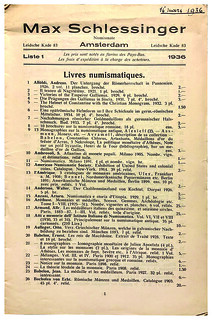 Max and his brother Paul, 26 and 22 years old respectively at the time, managed to escape. Mark Salton described his daring escape himself in his memoirs: some Dutch friends hid him from the Nazi thugs in Amsterdam, after which he made his way across France – first occupied France, then Free France – to the Pyrenees. He crossed the mountain range on foot, in forced marches, to surrender himself to the Spanish authorities in northern Spain. He was imprisoned in the concentration camp of Miranda de Ebro until the Dutch embassy in Madrid organized his departure to Portugal.
Max and his brother Paul, 26 and 22 years old respectively at the time, managed to escape. Mark Salton described his daring escape himself in his memoirs: some Dutch friends hid him from the Nazi thugs in Amsterdam, after which he made his way across France – first occupied France, then Free France – to the Pyrenees. He crossed the mountain range on foot, in forced marches, to surrender himself to the Spanish authorities in northern Spain. He was imprisoned in the concentration camp of Miranda de Ebro until the Dutch embassy in Madrid organized his departure to Portugal.
The Dutch embassy in Lisbon offered the multilingual Max Schlessinger a job. He probably would have become a high-ranking diplomat in the Netherlands if he hadn't decided to emigrate to the USA after the end of the Second World War.
When he arrived there, he adopted the name Mark Salton. He married the young Lottie Aronstein, who had suffered a fate similar to his own, within just three months of meeting her. Lottie had fled with her father and little brother shortly after the November pogroms and, after an odyssey halfway around the world, arrived in New York, where she earned her living as a diamond cutter.
Building the Salton Collection
Mark Salton may well have toyed with the idea of making a living in the coin trade, as his father had before him. In the 1950s, he was a familiar face in all American and European coin dealerships. He published a few fixed price lists, but they were published only in tiny numbers.
But just shortly after his arrival, Mark Salton found work as an analyst in the international department of Manufacturers Hanover Trust Company, one of the largest banks in New York at the time. He built up such a successful career that coin trading was no longer necessary. In 1966, he and his wife went to Rome for several years to run the Italian branch of Manufacturers Hanover Trust. During this time, the couple turned from dealers into collectors, with a particular interest in the art form of medals.
Mark Salton died after a fulfilled life on December 31, 2005, at the age of 92. He was followed in death by his beloved wife Lottie Salton, née Aronstein, on April 18, 2020.
The couple leaves us with a moving testament to the fact that, despite even the most terrible experiences, it is possible to start over. They decided to donate the proceeds from their collection to organizations that commit themselves to the remembrance of the victims of the Holocaust, to ensure that their fate is hopefully never repeated.
It is a great honor for Künker and Stack's Bowers Galleries that Lottie and Mark Salton have stipulated in their will that their numismatic collection be auctioned by the two auction houses in the USA and Germany. Künker has published a brochure in English and German detailing the story of the Hamburger, Schlessinger, and Aronstein families, as researched by Ursula Kampmann. You can view this brochure online (https://www.kuenker.de/data/kataloge/Kuenker_Broschuere_Salton-Collection_en.pdf) or order a copy from Künker for a nominal fee of 10 euros.
VOCABULARY TERM: HOLLOWBACK
Here's another entry from Dick Johnson's Encyclopedia of Coin and Medal Terminology. -Editor
Hollowback. Medals, checks, badges and pins made by the processes and equipment of the stencil industry rather than typical medal making. Such items are also called stamp and stencil and are identified by the following characteristics: (1) thin – struck on sheet brass; (2) uniface – only one die with a design is used; (3) low relief – little depth to the design; (4) usually blanked or trimmed unusual shape (since it is just as easy to blank in unusual shape as a round piece); (5) coin finish – no finish other than that of the struck brass; (6) possible flat back – (the back is the incuse of the obverse, after all it is a SHELL} very infrequently a separate BACKPLATE is applied to close off the back side. They are made at far lower cost than typical medals.
Because of the thin material such items can be struck on a drop hammer press rather than the heavier coin or medal presses. The blank reverse die – a jack die – often bore the maker's imprint or logo, incuse in the die this would be raised in the struck piece. The jack die could be used over and over again, it was not required to fit any size or shape. In those instances where relief of design was desired on the reverse sometimes a dummy force or scrap force was employed (or, of course, a typical reverse die).
Finally, the lightness of the finished product made them ideal for any type of medallic item to be worn – as a badge or pin – and were often fabricated in several parts and assembled. The pin as fastener on the reverse of such an item was often a safety pin soldered in place (but this was susceptible to breaking, or snapping off completely).
There was a widespread number of local manufacturers in the stamp and stencil industry in America. They also made rubber stamps, nameplates and similar related products, their equipment limited, obviously, the products they could make themselves. Local businessmen would come to these firms for a variety of products, including those of numismatic interest. They could manufacture low quality tokens and medals but would act, perhaps as an agent for better items, having them struck by firms with more specialized talent and equipment. A leading manufacturer of this class of medals in the United States was the Schwaab Stamp & Seal Company of Milwaukee.
To read the complete entry on the Newman Numismatic Portal, see:
Hollowback
(https://nnp.wustl.edu/library/dictionarydetail/516060)
WHO WAS THE FIRST COIN COLLECTOR?
American Numismatic Biographies author Pete Smith submitted this article with a great question: Who was the first coin collector?. Thanks! -Editor
Sometime around 600 BCE, a merchant east of Troy in the Kingdom of Lydia looked at two coins and noticed they were different. He set them aside and compared them as he acquired other coins. Unfortunately, Greek historian Herodotus did not record his name or a description of the extent of his collection.
Hoards of coins of a single type are studied as a representation of commerce at the time. When a hoard contains coins of all different types, it is considered to represent a systematic collection. Such early hoards have been found but not linked to a specific collector.
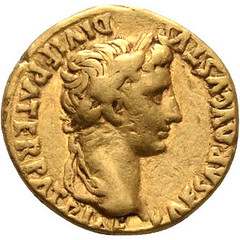 So, who was the first coin collector memorialized in print? According to the trusted source of
Wikipedia, the first famous coin collector was Caesar Augustus. He was born as Gaius Octavius
on September 23, 63 BCE. He got a job with the firm of his great uncle Julius and rose to the
position of CEO by 27 BCE. At least the story goes something like that.
So, who was the first coin collector memorialized in print? According to the trusted source of
Wikipedia, the first famous coin collector was Caesar Augustus. He was born as Gaius Octavius
on September 23, 63 BCE. He got a job with the firm of his great uncle Julius and rose to the
position of CEO by 27 BCE. At least the story goes something like that.
Augustus produced coinage under his own name and distributed it to his employees and local
merchants. According to a report by Roman historian Suetonius, Augustus gave coins of every
device, including old pieces of the kings and foreign money
on the festival of Saturnalia.
This has been interpreted as evidence that Augustus was a coin collector but I believe that evidence is very thin. Collecting coins and giving away coins are two very different activities.
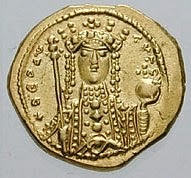 Jump forward a millennium to the Byzantine Empire and Theodora Porphyrogenita (980-1056).
She is the first woman mentioned in Wikipedia. This was reported by John Julius Norwich in the
second volume of his trilogy, Byzantium: The Apogee. Wikipedia states that she
Jump forward a millennium to the Byzantine Empire and Theodora Porphyrogenita (980-1056).
She is the first woman mentioned in Wikipedia. This was reported by John Julius Norwich in the
second volume of his trilogy, Byzantium: The Apogee. Wikipedia states that she Owned a large
collection of ancient coins and medals which she kept in custom-made bronze cabinets and
happily accepted new additions as presents.
Theodora's career in the family business did not go as well as Octavian's. Her attempts to become emperor were thwarted by her older sister Zoe. When Constantine IX died, Theodora became emperor for sixteen months briefly at age 74.
Caesar Augustus and Theodora Porphyrogenia are both represented on coins from their era. These might make an interesting exhibit of coin collectors who appear on coins.
I found documentation of these early collections to be very thin. Are there better sources to confirm the activities of these collectors? I call upon the smarty pants readers of The E-Sylum to come up with better candidates for recognition as the first coin collectors.
I'm curious to see what our readers come up with! -Editor
DON EVERHART'S CAREER IN COINS, PART 3
With permission, we're republishing excerpts of former U.S. Mint Sculptor-Engraver Don Everhart series published by CoinWeek beginning in April 2018. Last week Don wrote about how he came to enter a design contest for the second Clinton inaugural medal. -Editor
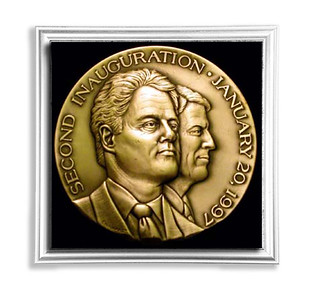 I worked for six weeks on the project and waited about a month until one day I received a call from Bob. I picked up the phone and waited in silence for quite a while until he uttered,
I worked for six weeks on the project and waited about a month until one day I received a call from Bob. I picked up the phone and waited in silence for quite a while until he uttered, Congratulations!
Needless to say, I was ecstatic.
I always enjoyed working from my own studio. I was my own boss and I could work my own hours. No commute, no early morning wake up call, etc. Most all the time I was very busy, and when I wasn't busy I hustled to get more work. Many days were spent on the phone or trips to New York for the annual giftware shows at the Javitts Center.
I always felt very lucky. Whenever I was slow and really needed to pick up commissions, they always seemed to happen. Of course, you make your own breaks, and I never hesitated to make it happen. Having a mortgage, car payments, a wife and kids has a way of motivating a young artist.
Sometime in the early 1980s I became a member of the fledgling American Medallic Art Association (AMSA). The organization works to encourage the creation, study and appreciation of the American fine art medal. Back in the beginning there weren't many members and I remember the group meeting in Domenico Facci's studio in Manhattan. We were united in our admiration and the continuation of the art of the medal in the United States and abroad. Through the years the organization continued to grow and now numbers about 133 members.
Despite the ubiquitous nature of technology today, the medal endures. In the beginning it was a vehicle to praise leaders and disseminate the news of the day. It's no longer where we get our news, but it survives because it is such a unique personal experience for the viewer. Unlike most sculpture exhibits with roped off sections and guards to prevent one from touching the work, the medal encourages touch. One can hold it in one's hand and marvel at the art. Many medals by top sculptors can be purchased for a fraction of what one would pay to own a larger piece.
Additionally, it has yet another dimension: the dimension of time. As one turns the medal over from obverse to reverse a segment of time is revealed. I utilized this idea to the max with my dinosaur series. As you turn over the obverse of the Tyrannosaurus Rex medal, you encounter the reverse–in this case the fossilized remains–65 million years later.
AMSA now has a worldwide following due to hard work and its participation in FIDEM (Federation International de la Medaille d'Art) exhibitions. The exhibitions are held every two years in a different European city, with occasional excursions to the United States and Canada. There you will see how different artists from different counties interpret the art medal. It's an enlightening experience to say the least. I have exhibited in a few and attended shows in London and Colorado Springs.
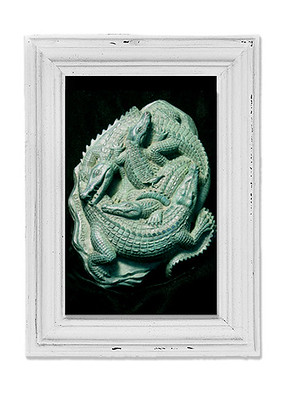 Not everything I have done is a commission. Back in the 1990s I produced a number of pieces for exhibit that attempted to stretch the boundaries of medallic art. Some were freestanding, non-round portrayals of reptiles such as
Not everything I have done is a commission. Back in the 1990s I produced a number of pieces for exhibit that attempted to stretch the boundaries of medallic art. Some were freestanding, non-round portrayals of reptiles such as Crocodile Rock
and Chameleon
. Unfortunately, I haven't produced much for myself lately but am hoping my retirement will afford me more time to work on my own art.
Around the early 2000s, freelance work began to diminish. This was due to a number of reasons.
One, giftware companies that I worked for were now shipping their sculpt projects to the Orient
.
Two, The Franklin Mint had saturated the market with coins and the new ownership decided to sell other products instead. They sold dolls, model cars, books, food! Everything but coins. At any rate, I could see the handwriting on the wall – I was going to have to get a real job! I always had it in the back of my mind since I began sculpting coins and medals that somehow, I would wind up at the U.S. Mint.
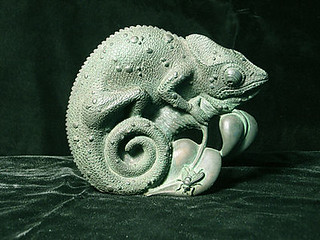 That idea became a reality on January 4, 2004, when I got up out of bed at 5am on a Monday morning and drove an hour in the dark to my new position as a Sculptor-Engraver at the United States Mint.
That idea became a reality on January 4, 2004, when I got up out of bed at 5am on a Monday morning and drove an hour in the dark to my new position as a Sculptor-Engraver at the United States Mint.
It's been a long, strange trip from that day when I walked into the gallery on South Street. Sometimes you make a decision and it turns out to be a monumental, life-changing experience.
Sometimes you have no idea of the ramifications it will have on your life path.
To read the complete original article, see:
Don Everhart: My Career in Coins, Part 1 – The Franklin Mint
(https://coinweek.com/modern-coins/don-everhart-my-career-in-coins-part-1-the-franklin-mint/)
You can see more of Don's sculpture and design work on his website:
http://doneverhartsculpture.com/?utm_source=coinweek
To read the earlier E-Sylum article, see:
Don Everhart's Career in Coins, Part 2
(https://www.coinbooks.org/v25/esylum_v25n06a17.html)
STEPHEN ALBUM RARE COINS AUCTION 42 RESULTS
Here's a press release with results for the Stephen Album Rare Coins Auction 42. More great prices! -Editor
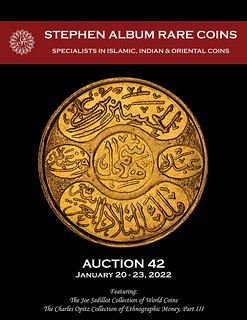 Stephen Album Rare Coins held its Auction 42 on January 20-23, 2022 at its offices in Santa Rosa, California. The
prices realized were yet another new record for the company coming in at $2.63 million (including buyer's fees)
with a sell-through rate of 97.4%. Some sections such as the Chinese coins achieved a nearly 100% sell-through rate.
Stephen Album Rare Coins held its Auction 42 on January 20-23, 2022 at its offices in Santa Rosa, California. The
prices realized were yet another new record for the company coming in at $2.63 million (including buyer's fees)
with a sell-through rate of 97.4%. Some sections such as the Chinese coins achieved a nearly 100% sell-through rate.
Many items went for multiples of their estimates, including some world record results. Several collections helped achieve those totals, namely the Joe Sedillot Collection of World Coins, Part I, and the Charles Opitz Collection of Ethnographic Money, Part III.
A selection of highlights follows (prices include buyer's fees):
CHINA: LOT 728: KWEICHOW: Republic, AR dollar, year 17 (1928), Y-428, L& M-610, "auto dollar" type, variety
with three grass blades, a bold lustrous strike! NGC graded AU53.
Estimated at $30,000-$40,000. Realized $192,000.
CHINA: LOT 711: KWANGTUNG: Kuang Hsu, 1875-1908, AR 50 cents, ND (1890-1905), Y-202, L&M-134, a lovely
lustrous mint state quality example! PCGS graded MS63, ex Joe Sedillot Collection.
Estimated at $10,000-$15,000. Realized $31,200.
WORLD: LOT 1070: PHILIPPINES: Fernando VII, 1808-1833, AR 8 reales, ND [1832-34], KM-A74, assayer JM,
countermarked crowned F.7o on Mexico 1824-Mo mint "Águila de perfil" or "Hookneck" type 8 reales, PCGS
graded EF40.
Estimated at $400-$600. Realized $24,000.
WORLD: LOT 1024: KOREA: Kwang Mu, 1897-1907, AR yang, year 2 (1898), KM-1120, interesting obverse die crack,
a wonderful lustrous example! PCGS graded MS64, ex Joe Sedillot Collection.
Estimated at $200-$300. Realized
$18,000.
ETHNOGRAPHIC: LOT 1721: SOLOMON ISLANDS: Santa Cruz Islands, feather coil money (3519g), 19th to early
20th century, Opitz p.142-43, Knox p.50, ca. 8.17m (26'-9½") long and 5cm wide (2"), rolled into a 5-layered
double-row coil ca. 35cm in diameter (14"), fully intact and covered in scarlet feathers, decorated with strings of
coix seed money and shells, a first-grade example (#1) in the traditional 10-tiered system and a superb specimen,
Unc, RRR, ex Charles Opitz Collection.
Estimated at $4,000-$6,000. Realized $18,000.
INDIA: LOT 491: BRITISH INDIA: Victoria, Queen, 1837-1876, AV mohur, 1841(b&c), KM-462.2, S&W-2.1, Prid-18,
East India Company issue, continuous legend, no initial on truncation, large date with crosslet 4, a very attractive
mint state example, PCGS graded MS61.
Estimated at $4,000-$5,000. Realized $13,200.
ANCIENT: LOT 45: SICULO-PUNIC: AR tetradrachm (16.95g), "People of the camp" mint, circa 320-300 BC, SNG
Fitzwilliam-1488 (same obverse die), Jenkins-161 (O49/R145), head of Arethusa/Tanit left, wearing barley wreath
and earring, four dolphins around, small shell below chin // head of horse left, palm tree with dates behind,
Phoenician `MMHNT (mintname) below truncation, light hairlines, some edge marks, bold VF.
Estimated at $1,000-$1,500. Realized $11,400.
ISLAMIC: LOT 254: SELJUQ OF RUM: Kayqubad I, 1219-1236, AV dinar (4.44g), NM, AH624, A-A1211.1, Izmirlier-
197 (same reverse die), central double circle on both sides, royal legend fills both the center and margin of the
obverse; the Abbasid caliph al-Mustansir cited in the margin and the date in words in the center on the reverse,
minor waviness on the surfaces, fully legible legends on both sides, of the highest rarity, VF, RRRR.
Estimated at $1,800-$2,400. Realized $10,200.
The firm is soon publishing an internet auction on March 7-8, which will feature 2,000 lots of a wide variety of all categories. They are also seeking consignments for their premier sale Auction 43, which will be held May 12-15, 2022. Please visit www.stevealbum.com for more information.
ROSA AMERICANA COLONIAL COINS PRICE LIST #22
E-Sylum supporter Jeff Rock of Rosa Americana, LTD has issued a new fixed price list of U.S. colonial coins. Here's his summary description and some sample pages. Great material here, with excellent writeups. To get your copy, contact Jeff at rosaamltd@gmail.com . -Editor
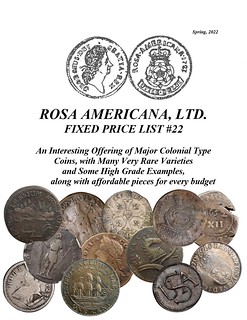 FPL#22 in 2022 has a good ring to it. While we are not out of the Covid pandemic things are getting better in most areas, and we have seen a return (admittedly spotty) to coin shows and life as we knew it prior to 2020. The C4 convention in Baltimore last November went on as planned, and though it was less crowded than in previous years, the energy and fun was there.
What wasn't there were a lot of colonial coins to buy – demand seems to have far outstripped supply, and as everyone who has bid in auctions recently knows, that has led to increased prices nearly across the board.
FPL#22 in 2022 has a good ring to it. While we are not out of the Covid pandemic things are getting better in most areas, and we have seen a return (admittedly spotty) to coin shows and life as we knew it prior to 2020. The C4 convention in Baltimore last November went on as planned, and though it was less crowded than in previous years, the energy and fun was there.
What wasn't there were a lot of colonial coins to buy – demand seems to have far outstripped supply, and as everyone who has bid in auctions recently knows, that has led to increased prices nearly across the board.
One of the few good things that seems to have come from this pandemic is that people are turning back to hobbies of their youth – or finding new ones – and numismatics in general has been the beneficiary of that increased interest. There were new faces at the C4 convention (as well as on the Google discussion group – which if you haven't yet joined you should, contact me for details!), both collectors and dealers, and that is gratifying to see.
The C4 Newsletter and The Journal of Early American Numismatics continue to produce exceptional reading material. It is rare for a small part of the hobby to have two award-winning journals associated with it, but colonials have done that for 25 years – please support them by becoming a club member and subscribing to JEAN through the ANS website (you do not need to be an ANS member to get the journal, though it is less expensive if you do). Knowledge is the best investment, and these two publications are worth many multiples of their cost.
For this price list, we've strived to give a good mixture of pieces, ranging from a few hundred to several thousand dollars, with grades ranging from well-used to fully Uncirculated (and even a proof). You'll find a smattering of major type coins, very rare varieties (including some extremely rare and even one unique piece), and coins with provenances to some major collections. We've added in W
numbers to these listings, as many collectors are using Q. David Bowers' Whitman Encyclopedia of Colonial and Early American Coins, the first single-volume reference work for the colonial series (now in a greatly improved second edition).
All are coin offerings have been thoroughly described and photographed to show the true color of the piece – and all are guaranteed to satisfy. As always, your satisfaction is the most important part of our business, and the only reason we are still dealing in colonial coins, some 33 years (!) after our first price list. That doesn't just mean we guarantee our attribution and the authenticity of what we offer, but also that the coin fits your needs – study it for two weeks and if it doesn't, simply return it for a full and immediate refund.
If you didn't receive that Christmas present you really wanted – or are looking for an unusual Valentine's Day gift? – read on! This offering is a small part of our inventory, and if you are looking for something specific, please let us know – we just might have what you need.
DIX NOONAN WEBB OFFER IRISH COINS
Dix Noonan Webb are offering an interesting sale of Irish coins, tokens and medals on March 3, 2022. -Editor
An intriguing and extremely rare Irish coin dating from 1927 that was designed by an Italian but was never put into circulation is among the highlights of the sale of Irish Coins, Tokens and Historical Medals by Mayfair-based international coins, medals, banknotes and jewellery specialists Dix Noonan Webb on Thursday, March 3, 2022.
Known as the Free State Penny (1921-1937), the bronze penny in the sale, which is decorated with a harp on one side, and hens and chickens on the other, was designed by Roman sculptor Publio Morbiducci (1889-1963) for the competition to design Ireland's new money in 1928. He was ultimately unsuccessful and the precise numbers of pieces which now exist are uncertain. In 1976, it is believed that only three pieces existed in bronze. It is estimated at £4,000-5,000 and is part of a collection that was amassed between 1972 and 1978 by a gentleman and is being offered at auction for the first time.
Elsewhere in the sale is a large collection of Irish Gunmoney and Emergency Issues of 1689-1691 from the collection of John Rainey. Many of the lots are duplicates from the main study group used to produce the most recent book on the subject, Irish Gunmoney and the Emergency Issues of 1689-1691, A Corpus and Die Study, by Paul and Bente R. Withers in 2020, and is believed to be the most extensive group to ever come up in one auction. These coins were made from metal from cannon and were only produced at two mints in Ireland, Dublin and Limerick. Interesting items in the sale include a silver proof halfcrown from the reign of James II, dating from May 1690 and produced in Dublin. Only five specimens are known and it is estimated at £3,000-4,000, while from Limerick a rare halfcrown, dating from March 1690, is estimated at £300-400.
A further group of tokens from the collection formed by the late Barry Woodside, also features. Belfast-born Mr Woodside had a great interest in numismatics, particularly Irish tokens, which began in the early 1980s. The sale will include tokens from Belfast, Cork and Tipperary, among other locations. A very rare farthing issued by James Armstrong & Co and William Armstrong & Son of Armagh and Lurgan is expected to fetch £150-200; while a very rare copper fourpence from the Moy Hotel in Ballina, Mayo, produced by Parkes [1861-72] is estimated at £120-150. From the 17th century is a lead penny from Tipperary, which is also estimated at £120-150 and a brass twopence-halfpenny, estimated at £100-150, believed to have been issued by Thomas Murphy, innholder of the Apollo, 8 Hawkins Street, Dublin between 1860-78.
For more information, see:
https://www.dnw.co.uk/
THE BOOK BAZARRE
WORLD BANKNOTE AUCTIONS SALE 22
Here's the press release for World Banknote Auctions upcoming Live Sale 22. Some very nice notes here. -Editor
This week World Banknote Auctions has listed Live Sale 22, which closes in two different segments. The first segment, the traditional live sale, closes on March 3, 2022, with live bidding that day at 1 PM Eastern / 10 AM Pacific. The following day, on March 4th at 1 PM Eastern / 10 AM Pacific an additional segment closes in a timed auction (no live bidding, although lots may be extended if a bid is received 10 minutes before closing). Live Sale 22 offers 790 lots from around the world, with select highlights including key notes from around the world, classic type notes and modern issues in high grade. Some highlights are selected below, the entire catalog can be viewed on the company's website, www.worldbanknoteauctions.com.
Lot 22060 is the highest denomination of the British Caribbean Territories series with portrait of Queen Elizabeth II in specimen (Pick-12cs). Dated January 2nd, 1957 it is graded Choice About Uncirculated 58 EPQ by PMG and is free of any writing typically seen on specimens of this series. It is part of a complete specimen set in this sale, but the $100 is extremely rare in issued form, making it a great opportunity for someone wishing to acquire an example of this type note. It carries a pre-auction estimate of $4,000-$5,000.
Lot 22062 is a true rarity in the British Commonwealth series. It is a fully issued British Guiana 1.1.1942 Twenty Dollars (Pick-16) graded Very Fine 20 (with a comment for minor repairs) by PMG. One of just three issued examples in the PMG population report, it is estimated that there are perhaps half a dozen issued notes known to exist in all grades. This issue, which features an eye-catching and famous design of the Kaieteur Falls represented a large sum of money at the time of issue and circulated in a far flung British Colony, making survivors a rare treat indeed. This rarity carries a pre-auction estimate of $20,000-$25,000.
Lot 22115 is one of the earliest issues for Panama. While the short lived 1941 Arias
series is well known, prior to the independence of Panama (when it was a part of the modern country of Colombia) notes were also issued specifically for what later became Panama. This 2 Pesos (Pick-S187r), is a remainder from the Estado Soberana de Panamá and is dated 1871. It has been graded Extremely Fine 40 by PMG (with comments for a corner Cut Cancelled and spindle holes). A very difficult issue to locate, particularly at this grade level, it carries a pre-auction estimate of $2,500 to $3,000.
Lot 22154 is a PMG Superb Gem Uncirculated 67 EPQ graded example of the ND (1988) $100 from the East Caribbean States, overprinted for Anguilla. Tied for the finest known in the PMG population report notes of this denomination have become extremely popular with collectors since they were issued, and many varieties are very scarce in higher grades. This modern rarity carries a pre-auction estimate of $2,000-$2,500.
Lot 22247 is a very underrated issue from Honduras. This 1932 1 Lempira (Pick-34) is graded Very Fine 25 by PMG. Despite its relatively low face value few were saved, and this note is the single finest in the PMG population report. It is a very scarce type and carries a pre-auction estimate of $400-$500.
Lot 22310 is a very unusual banknote from Lebanon. This 1939 1 Livre (Pick-26c) is graded Choice UNC 64 by PCGS Banknote. What makes this note special is the fact that it contains signatures of what appear to be a number of journalists that were stationed in the country sometime in the 1940s. Perhaps this note was passed around a bar or hotel at some point and signed as a memento. An interesting banknote worth of additional research, it carries a pre-auction estimate of $350-$400.
Lot 22394 is a specimen issue from Portuguese India. This 600 Escudos from 1959 (Pick-45s) is graded Gem Uncirculated 66 EPQ by PMG. An odd denomination that was part of the final series of Portuguese India, it is very rare in higher grades in issued form, making specimens such as this a much more affordable alternative. It carries a pre-auction estimate of $600-$800.
Lot 22422 is an undated 10 Nouveaux Francs (Pick-33) from Saint Pierre & Miquelon, graded Superb Gem Uncirculated 67 EPQ by PMG. The islands of Saint Pierre & Miquelon remain French to this day and are the last remnants of French's once vast colonial empire in North America. A popular series to collect, there has been an uptick in demand recently for high grade examples. This particular example carries a pre-auction estimate of $1,000-$1,200.
Lot 22490 is a PMG Very Fine 30 graded example of the Swedish 1958 10,000 Kronor (Pick-49). The highest denomination ever issued in Sweden, this note is physically quite large and difficult to find in problem-free grades. It is the highest denomination ever issued in Sweden and only exists with the 1958 note. It carries a pre-auction estimate of $3,000-$3,500.
Lot 22518 is the iconic old man
note from South Vietnam, the ND (1955-56) 1000 Dong issue (Pick-4As) in specimen form. Never issued, this note is one of the classic world banknotes and is in demand from collectors around the world. They exist in both proof and specimen format. This particular example is a specimen with watermark and red control number. It carries a pre-auction estimate of $15,000-$20,000.
To read the complete article, see:
World Banknote Auctions Presents Live Sale 22
(https://www.worldbanknoteauctions.com/news/world-banknote-auctions-presents-live-sale-22/)
HOLABIRD FEBRUARY 2022 SALE SELECTIONS
Here are some numismatic items that caught my eye in the February 2022 Holabird Western Americana Collections LLC sale. -Editor
Old style, pre World War II logo of the Mint of the United States at San Francisco. Number 1366 / 999.75 / Fine. Reverse: 6.61 ozs.
Great item - seldom seen. -Editor
To read the complete lot description, see:
U.S. San Francisco Mint Silver Ingot [145806]
(https://holabirdamericana.liveauctiongroup.com/U-S-San-Francisco-Mint-Silver-Ingot-145806_i44229208?t=HEBWT6)
Fanciful propaganda scrip c. 1907 used by Goldfield, NV mine union workers demanding cash pay from the mine owners headed by George Wingfield who had instituted a scrip system as one way to break the union. Obverse reads "Exploitation Mercantile Company," "Good for Five Dollars in Trade," Branch of the Consolidated Mines Company," "Teddy Bear Currency," signed by E.Z. Marks/Cashier. Reverse reads "This is the Only Kind of Money Nevada Will See if the Goldfield Miners Union Lose the Strike Against the Infamous Scrip System."
Accompanying article and photos from Online Nevada Encyclopedia. This is unarguably the most important Nevada scrip note extant, and this piece is in AU+ condition, possibly the finest known. Mining company scrip was commonplace in eastern US mines, made an introduction into Colorado and some other western states, but never took off as a money source. Out west, miners wanted to be paid in gold and silver, the same metals that they mined. In Nevada, nobody accepted the scrip system, and it collapsed after the miners strikes around the West in the c1905-1915 period. Extremely rare.
Wow - very interesting item. I wasn't aware of this strike or scrip. A numismatic item issued in protest of another numismatic item. -Editor
To read the complete lot description, see:
Miners Union Scrip, Goldfield (Fanciful, Very Rare) [145082]
(https://holabirdamericana.liveauctiongroup.com/Miners-Union-Scrip-Goldfield-Fanciful-Very-Rare-145082_i44229148?t=HEBWT6)
Canvas bag, 19 inches tall by 13" wide. Measuring 10 inches down from the top, it reads, horizontally, in letters 1/2 inch tall: "U.S. Mint / Carson City / Nevada." On the reverse is written 5/8.5 in purple ink. A similar bag sold in our April 2015 auction for $900.
These are way cool. Great display item. Imagine if it were still filled! -Editor
To read the complete lot description, see:
Carson City U.S. Mint Bag [146104]
(https://holabirdamericana.liveauctiongroup.com/Carson-City-U-S-Mint-Bag-146104_i44229162?t=HEBWT6)
Messers Manilal Chimanlal & Co. 10 tolas. (4.1 ounces). 45 x 31 mm. Although the exact years of production for these bars is not known, the bar features the map of undivided India on one side so it was probably minted before 1947 when the partition happened. Also, there are 5 Tolas and 10 Tolas bars with the H.M. Mint (His Majesty's Mint) crown logo which was renamed to India Government Mint in 1947 and this is one more reason to believe that these bars were produced during the British-India rule before independence.
Interesting piece. Do any of our readers collect ingots? -Editor
To read the complete lot description, see:
Silver Ingot from India [145997]
(https://holabirdamericana.liveauctiongroup.com/Silver-Ingot-from-India-145997_i44229170?t=HEBWT6)
Hudson Bay Company 1820 one pound sterling certificate. Issued June 1821 at York Factory in Ruperts Land. Signed by Governor Williams (sp?) and Accountant John Spencer. Payable sixty days after sight at the Hudson Bay House, London. Other Hudson Bay one pound sterling certificates sold for $1,100 in 2009 and $900 in 2011. Once framed, now glued to cardboard backing, Otherwise in good condition. Rare and early piece.
Cool item from the Governor & Company of Adventurers of England. -Editor
To read the complete lot description, see:
Hudson Bay Company 1820 One Pound Sterling Certificate [144995]
(https://holabirdamericana.liveauctiongroup.com/Hudson-Bay-Company-1820-One-Pound-Sterling-Certificate-144995_i44229146?t=HEBWT6)
New York City Draft Riot Damages Check. Partially printed check # 4291, issued to Robert C. Hutchings for $250, drawn on the Broadway Bank, New York, dated October 31st, 1863, signed by Matthew Brennan/Comptroller, for services as Secretary of Committee on Riot Damages. Also signed by the Mayor of New York City and the Clerk Board Superintendent (handwriting illegible). Blue printed lettering with Riot Damages in red ink on left edge printed vertically. Two holes in center of check indicate slash cancellation.
Note: Riots broke out throughout the country following passage of President Lincoln's Conscription Act passed in March of 1863 which allowed men of means to avoid having to join the Union Army by hiring a substitute or paying a $300 fee. That summer, on July 13th, working class men in New York City, mostly Irish Americans, took to the streets for four days, leaving as many as 1,000 people dead, mansions and store fronts looted and burned down, while lynch mobs terrorized Blacks (who only later were conscripted into military service as soldiers). A colored orphan asylum was set on fire. Order was restored only after five regiments were sent in from Gettysburg armed with cannons and Gatling guns.
Very cool and historic item. I don't believe I've ever seen one of these before. -Editor
To read the complete lot description, see:
New York City 1863 Draft Riot Damages Check [145088]
(https://holabirdamericana.liveauctiongroup.com/New-York-City-1863-Draft-Riot-Damages-Check-145088_i44229164?t=HEBWT6)
Seated Liberty quarter dated 1853 (with arrows) counter stamped "J. M. Taylor / Broker / Brooklyn. L. I." Listed in Rulau's "Standard Catalog of United States Tokens" on pages 325 and 359. Rulau says two known.
Nice example on a scarcer undertype. -Editor
To read the complete lot description, see:
Counter Stamped Seated Liberty Quarter [146191]
(https://holabirdamericana.liveauctiongroup.com/Counter-Stamped-Seated-Liberty-Quarter-146191_i44229264)
HK-783 Silver, reeded edge, 38 mm, Uncirculated condition.
Obv. In 13 lines, first and last curved, others straight, A Government Dollar / Contains / 412 1/2 Grains / of Silver 900/1000 Fine / This Piece of Silver / is the Size and Weight of / a Government Dollar / Containing / 412 1/2 Grains of Silver 900/1000 Fine / and its Value / July 5th 1900 / was 48 Cents / Gorham Mfg. Co. Silversmiths; no rim. Rev. In five straight lines, Market Value / July 5th 1900--48 Cents / Coinage Value / at the Rate of 16 to 1 100 Cents / ?; no rim.
Nice item! -Editor
To read the complete lot description, see:
Bryan Dollar: HK-783 [142454]
(https://holabirdamericana.liveauctiongroup.com/Bryan-Dollar-HK-783-142454_i44229327)
JOFFRE CANADIAN HISTORICAL MEDALS COLLECTION
Geoffrey Bell Auctions April 28, 2022 Toronto Coin Expo Sale #26 sale features the Michael Joffre Collection of Canadian Historical Medals, catalogued by Jacob Lipson. An article written by the consigner describes his numismatic journey. -Editor
Michael Joffre Collection of Canadian Historical Medals
In 1979, as an eight year old boy, I stumbled across a jar of old European coins in my grandfather's house. Upon discovering me on the floor with 100's of coins scattered around, he told me I could choose any one I wanted to keep. The Sweden 1736 1 Ore in VG that I selected started a collecting bug and has led to an incredible numismatic journey that has been one of my great passions in life.
The first LeRoux medal I acquired was as a teenager: a LeRoux 1875. That piece sat in a drawer, and I looked at it every now and then and wondered what other Canadian medals were available. During the years that followed, I collected in many numismatic areas — Roman, French, English, and American — but neglected to explore further Canadian medals.
In the early 2000s, my good friend and numismatic mentor Bill Whetstone acquired a nice collection of French coins, which included some very interesting medals (including the classic 1760 Montreal Taken medal in silver), he agreed to sell the whole group to me … and the medal voyage had truly begun.
Like in most areas of collecting, the first place to start was to find books. A 1960s reprint copy of LeRoux was available in the Carsley's library, and I brought it home to study. Shockingly, I was surprised to learn that in the century that passed, despite advancements in almost all areas of numismatics, no other standard reference had been written on the general subject of Canadian historical medals. There were some references on specific areas, but no grand treatise. This was in a way exciting, rather than a negative. I went off to find pieces, learn more about these wonderful artifacts, and see if I could find all of the medals in the LeRoux catalogue … and maybe others he missed.
Canadian historical medals represent a severely underrated area of numismatics. In terms of rarity, almost every piece in this catalog is significantly rarer than almost any important Canadian decimal coin. In terms of historical significance, each piece is an important part of our history and culture. In terms of artistic merit, few other items in numismatics can compare to the large three dimensional objects created by true artists of sculpting and engraving.
The medals in this catalogue are the result of two decades of actively buying from private collections, participating in major and minor auctions, hunting at shows, and trading with friends in Canada and abroad. I have had the pleasure of examining thousands of pre-1897 historical medals, and acquired about 1,000.
The focus was more on a broad type set, but opportunities came up to buy named pieces, and specialized groupings as well.
For years, I was looking for a way to provide some sort of update to the medal part of LeRoux, especially since the supplement has no pictures, and most of the information is limited. My journey with the collection was reaching maturity, and it was time to let others enjoy these medals as well. I contacted Brian Bell with the idea of creating a catalogue of my collection that would be an auction, but with a bit more detail than usual, so it could also serve as a future reference to the hobby. Brian could not have been more supportive, and I would like to thank him, Dawn, and Geoffrey for all of their hard work and trust.
Of course, there was only one person who I knew could cover the broad spectrum of LeRoux medals with the excitement and research it required, and my next call was to Jacob Lipson. His ability to research and synthesize information, and then translate it into easy-to-read descriptions is spectacular. This catalogue could not have been written without him.
Jacob Lipson wrote this introduction to the sale. -Editor
Welcome to what promises to be a special night for Canadian numismatics. The breadth and quality of this collection make it one of the most important offerings of its kind in a generation, one that will surely stand the test of time.
The medals in this sale are tangible artifacts of Canadian history. Many of them have been avidly pursued by advanced collectors for centuries and represented in the finest cabinets. In some cases, examples may only come to market every 30 or 40 years. Hopefully, our presentation of The Michael Joffre Collection of Canadian Historical Medals continues to foster and stimulate interest in what should be regarded as a series of considerable historical significance, and in medal collecting more broadly.
It takes a certain kind of collector to put together a set as diverse and extensive as the one offered here. Dedication and enthusiasm are prerequisites, which Michael possesses in spades. From the outset, his goal in putting together this group has been clear: To collect every medal listed in the landmark 1888 reference, The Canadian Coin Cabinet, by Dr. Joseph LeRoux, and, in so doing, to focus on rarity, quality, and completeness. Dr. LeRoux's catalogue, which was last updated in 1897, can be difficult to follow. It contains mistakes, omissions, and other inconsistencies. Any collector brazen enough to collect LeRoux medals methodically has to negotiate those obstacles. They must also commit themselves to the pursuit of an incredibly wide range of medallic types from iconic 17th century rarities to late-19th century souvenirs. Michael always embraced the challenge.
Never afraid to step up to to the plate or go out on a limb, Michael has been an active participant in major auctions across Canada, the United States, and Europe for three decades. He has, over time, acquired many of the stand-out keys in Canadian (and North American) numismatics. Michael has also successfully obtained countless under-the-radar rarities, many of which have come to market only once or twice over a lifetime of collecting.
As a long-time coin dealer in Montreal and a proud native of that city, Michael could have chosen to part with his extraordinary collection in any number of ways. He insisted, however, on leaving something to future generations — a de-facto update of LeRoux's 1888 reference that collectors could refer to years and even decades into the future. In that vein, I have done my best to incorporate as much relevant information as possible into the pages that follow and to convey what makes each and every item in this sale so intriguing. Hopefully, Michael's passion for these remarkable medals comes through as well.
A few housekeeping items: Michael and I have made the decision to offer all lots in the order in which they appear in the LeRoux catalogue. As such, historical medals can be found among school medals and Indian peace medals with exposition medals interspersed.
To read the complete catalog online, see:
http://www.torontocoinexpo.ca/documents/S26%20Spring%20Expo%20Listing%20part1.pdf
NUMISMATIC NUGGETS: FEBRUARY 13, 2022
Here's a selection of interesting or unusual items I came across in the marketplace this week. Tell us what you think of some of these. -Editor
Two Exhibition Prize Medals, to JV Hill, saw manufacturers, London 1851 and Paris 1855, frame 34cm. wide, and a collection of Victorian coin tokens, in Pinches & Co. case, 1857
Nice framed display set. -Editor
To read the complete lot description, see:
(https://www.easyliveauction.com/catalogue/lot/
347d1e5d9ec08870f264436833da8068/0af8d24542e81eb9357e7ef448a6646f/
gorringes-antiques-auction-furniture-miscellaneous-lot-497/)
FIRST PRIZE MEDAL CARVED INTO MORGAN DOLLAR
A more crudely fashioned prize medal. Interesting use of a silver dollar as a host. -Editor
To read the complete lot description, see:
FIRST PRIZE MEDAL CARVED INTO MORGAN DOLLAR
(https://live.silvercityauctions.com/lots/view/4-51WOEA/first-prize-medal-carved-into-morgan-dollar)
Strange item - that elongated multi-purpose "G" is unusual, as is any vertically-oriented oval token. -Editor
To read the complete lot description, see:
St. Bernard, Ohio Token. Greg's Grill Garden. 5c In Trade.
(https://www.barnebys.com/auctions/lot/st-bernard-ohio-token-greg-s-grill-garden-5c-in-trade-r8qEJzzb8f)
CROATIAN COIN COPYRIGHT CONTROVERSY
David Sundman shared this article about the Croatian coin copyright controversy. Thanks! He writes, "Interesting article here, both the copyright issues and the origin of the ‘kuna' unit of currency." -Editor
A Scottish photographer has blocked the release of a Croatian coin because he believes it breaches copyright by featuring his work.
Iain Leach, 63, took a picture of a pine marten on a tree branch on June 8, 2005, in Scotland.
He was baffled to learn that a near-identical picture won a contest for a €1 coin, to be launched next year when Croatia joins the euro.
The designer who submitted the picture to the Croatian National Bank has withdrawn the image — and is said to have handed back a prize of €10,000.
Leach, from Newton Stewart in Dumfries and Galloway, a retired consultant, said he had no plans to sue and wished Croatia well in choosing a new design.
In the Middle Ages, marten pelts were used as a form of currency and an image of a marten appears on the Croatian currency. The Croatian word for marten, una, is the name of the current currency in Croatia.
To read the complete article, see:
Croatian coin stole pine marten picture, claims Scottish photographer Iain Leach
(https://www.thetimes.co.uk/article/croatian-coin-stole-pine-marten-picture-claims-scottish-photographer-iain-leach-m87phn2vp)
SHAKESPEARE MEDAL REUNITED WITH FAMILY
An ANS Pocket Change article published last month describes an interesting William Shakespeare medal recently deaccessioned by the society. Here's an excerpt - see the complete article online for more. -Editor
One of the more fascinating aspects of the American Numismatic Society's eBay store are the numismatic stories that come with the objects we are privileged to offer. While every object has a story to tell, we aren't always privy to the full story, apart from what we know about how they were made, who issued them, and where they circulated generally. But certain specifics—exactly whose hands something passed through, for example—are often lost to time, with the exception of pedigreed objects and the like. However, when the provenance or previous ownership of an item isn't committed to paper, it is sometimes committed to the object itself in the form of an inscription or engraving.
Such is the case with a silver medal honoring William Shakespeare (or Shakspeare
as it is spelled on this medal, one of 80 different spelling variations used over the years) inscribed to John Halhed Esqr.
on the edge. This small fact was noted in our eBay listing and subsequently allowed a living descendant of John Halhed—his 4x great-grandson Michael Halhed—to find the listing using eBay's saved search functionality, and ultimately win the auction.
First, some background on the medal itself. The original listing noted that this was a Beautiful 1803 National Edition of Shakespeare medal in silver
and featured on the obverse Shakespeare seated on a rock flanked by the Dramatic Muse and the Genius of Painting with HE WAS A MAN TAKE HIM FOR ALL IN ALL I SHALL NOT LOOK UPON HIS LIKE AGAIN
below said rock. On the reverse we find the lengthy inscription THIS MEDAL REPRESENTING SHAKSPEARE BETWEEN THE DRAMATICK MUSE AND THE GENIUS OF PAINTING IS RESPECTFULLY PRESENTED TO THE PERSON WHOSE NAME IT BEARS IN GRATEFUL COMMEMORATION OF THE GENEROUS SUPPORT GIVEN BY THE SUBSCRIBERS TO THE GREAT NATIONAL EDITION OF THAT IMMORTAL POET I.I. & J.N. BOYDELL AND G. & W. NICOL. 1803"—providing us with a great wealth of information about this medal, why it was issued, and who would have received it.
At 48 mm, the medal was designed by Conrad Heinrich Küchler (c. 1740–1810) —a German engraver who worked for Matthew Boulton at his famous Soho Mint. For many years, Küchler was the sole artist employed in designing and die-cutting the many coins, medals, and tokens produced by the Soho Mint, including the one pence and two pence cartwheel
coppers of George III. Credit must also be given to Thomas Banks (1735–1805) who sculpted the monumental Shakespeare attended by Painting and Poetry which Küchler used as the basis for his obverse design.
A gold example housed at the British Museum contains the following curatorial note: There are gold and silver examples of this medal in the British Museum, that in gold having been presented to George III. The name of the recipient is engraved on the edge of the medal whilst others are inscribed in impressed capitals: STRUCK IN THE MINT OF M . BOULTON. The flans vary slightly in thickness. There is a trial striking of the obverse die in bronzed lead in the Birmingham Museum and Art Gallery. Because of delays in striking the medals they were not available to subscribers until 1805.
The ANS medal was inscribed to John Halhed and purchased by his 4x great grandson Michael Halhed. -Editor
The American Numismatic Society is pleased to announce that the Shakespeare medal shown above is now back in Halhed family hands, joining letters (including a stamp-less letter sent from Australia to England in 1843 from one of John's sons, sent to a cousin), postcards, a pocket watch mechanism from the early 1700s, paintings, sketches, and several books. eBay and other auction sites have expanded and combined collecting interests to create a new generation of hobbyists who enjoy many aspects of history.
To read the complete article, see:
JOHN HALHED INSCRIBED WILLIAM SHAKESPEARE MEDAL REUNITED WITH FAMILY
(http://numismatics.org/pocketchange/halhed/)
1796 CANAL LOTTERY TICKET
While not exactly numismatic, early lottery tickets are an interesting adjunct to collections of early paper money. Often printed by the same firms using the same technology as paper money, they provide a fascinating glimpse into the colonial era. This item in the February 26, 2022 Early American History Auctions sale is a ticket that helped fund a failed Philadelphia-area infrastructure project. -Editor
January 1, 1796-Dated Federal Period, Philadelphia, Pennsylvania, CANAL LOTTERY, No. Two.
(for the Schuylkill & Susquehanna, and Delaware & Schuylkill Canal Company), Winning Ticket with $100 Doll
written on its face and winner's names on back, Choice Extremely Fine.
A historic ornately typeset bordered early Federal Period Lottery Ticket. It measures 2.25 x 5.5 printed on fresh, bright clean white laid period paper. It is from Philadelphia, is Signed, (Timothy) Matlack
as secretary which is cross cancelled as the Ticket was paid. It is hand noted 100 Doll
(dollars) at upper right and $100 at upper left, indicating the winner's amount in the drawing.
The Schuylkill and Susquehanna Navigation Company was a limited liability corporation founded in Pennsylvania on September 29, 1791. Vignette of a Sailing Ship, Plow and Sheaf of Wheat within an oval in the left indent border. A choice piece of Early American lottery history that has a near invisible standard cut cancel at left and appears bold in print and near new. The last winning
example of this Lottery we offered was in our EAHA Auction of July 9, 2016, Lot 195, which sold for $480. A great looking Colonial era lottery ticket.
The Schuylkill and Susquehanna Navigation Company was a limited liability corporation founded in Pennsylvania on September 29, 1791. This project became the goal of the Society for the Improvement of Roads and Inland Navigation organized in 1789 with preeminent, Revolutionary Wartime financier Robert Morris as president, David Rittenhouse, William Smith and John Nicolson. The Society petitioned the PA. General Assembly to again survey the river routes, only this time the State acted upon the recommendations.
The company was founded for the purpose of improving river navigation which in the post-colonial United States era of the 1790s meant improving river systems, not canals. In this Pennsylvania scheme, however, two rivers, a large river, the Susquehanna and a smaller one, the Schuylkill were to be improved by clearing channels through obstructions and building dams where needed. To connect the two watersheds, the company proposed a four-mile summit level crossing at Lebanon Pennsylvania, a length of almost eighty miles between the two rivers.
The completed project was intended to be part of a navigable water route from Philadelphia to Lake Erie and the Ohio valley.
The lot description has more information on the history of the doomed project. Of course, at the time its proponents were hopeful that the engineering challenges could be overcome, and had it succeeded it could have greatly impacted the city's fortunes. -Editor
To read the complete lot description, see:
1796 Ornate Canal Lottery
$100 Winning Lottery Ticket
(https://www.earlyamerican.com/Auctions/ClientPages/lots.item.php?auction=2&lot=342)
BUNDESBANK DRIES FLOOD MONEY
In the filthy-lucre department, here's a story about how the Bundesbank dried and counted the waterlogged banknotes from the recent flood. -Editor
The Bundesbank processed the flood money from the Ahr Valley using standard household tumble dryers. One of them is now moving to the House of History in Bonn.
It is a very unusual case for the Bundesbank: it has never had to process so much wet and dirty cash as from the flood disaster in the Ahr Valley.
From July 2021 to the end of January 2022, it accepted and refunded notes and coins worth more than 100 million euros.
A good 1.5 million wet banknotes were handed in, some of which were also contaminated with oil and dirt.
The number was also so high because Volksbanks and savings banks in the region had also been flooded with their safes.
Around a million wet banknotes came from banks and 500,000 from private individuals.
The Bundesbank has hired additional employees to dry the banknotes and has purchased a number of household tumble dryers.
One of them is now coming to the House of History in Bonn to commemorate the extraordinary event.
The bills had to be carefully dried in order to be counted; otherwise bundled bills in particular would have formed hard packets.
In addition to the dryers, tennis balls were purchased, which were put in the dryers to avoid tilting during drying.
The Bundesbank also used cobblestones to smooth the banknotes out of the dryer.
Fragrance additives were also put into the dryers, because otherwise the fumes from the dirty flood money would have been unbearable.
"It wasn't solemn," said Beermann.
In addition, one could only fill the money of one submitter in one round at the dryer, so that it was clear afterwards how much the person was reimbursed.
To read the complete article, see:
Bundesbank dries flood money: One citizen got a million euros wet
(https://www.tellerreport.com/business/2022-02-09-bundesbank-dries-flood-money--one-citizen-got-a-million-euros-wet.SkUZuV4by5.html)
HIGHLAND MINT MAKES SUPERBOWL LVI COINS
Local news outlets are great for backstories on numismatic artists and makers. Here's an excerpt from an article from Florida about the Highland Mint and Superbowl coins. -Editor
Everyone has a favorite part of their annual Super Bowl viewing experience, whether it be the game, halftime show, commercials or even a combination of all of those things.
But for Brevard residents, the pre-game coin toss may just have a little more meaning.
Indeed, the coin used to determine which team will get the ball first and which end of the field each team will defend in Super Bowl LVI is produced by The Highland Mint, located at 4100 N. Riverside Dr. in beachside Melbourne.
Obviously it gives us a different perspective on watching the game and especially not missing the coin toss, but it's nice to know that the game doesn't start without us and it's really an honor to be a part of the biggest football game of the year or maybe the biggest sporting event of the year,
said Vincent Bohbot, executive vice president of The Highland Mint.
Mr. Bohbot said that the coin measures 39 mm in diameter, which he added was about the size of a U.S. silver dollar
and weighs approximately 1 oz.
He also noted that the coin is silver-plated
and selectively-plated with 24-karat gold,
which gives off what he refers to as a two-tone effect.
He also stated that prior to the conference championship games, which determine which two teams will play in the Super Bowl, coins representing the four possibilities for games are readied.
The day after the championship games and we know the final two teams, we go into production immediately and the first 100 coins go to the NFL and it's our understanding that the referee gets 00 and No. 1 and in some cases or most years No. 1, the coin that's used for the coin toss, goes to the Hall of Fame,
Mr. Bohbot said. Last year however, they (the NFL) decided to auction off the coin that they use for the coin toss and it auctioned off for $13,000.
Mr. Bohbot said he believed that The Highland Mint first began producing the coin used at the pre-game coin toss in the 1993 Super Bowl XXVII where the Dallas Cowboys defeated the Buffalo Bills 52-17.
I just want to say that we have nothing to do with the outcome on which side it's going to fall,
said Mr. Bohbot, jokingly. So it's not our fault if it doesn't go to your team.
Another coin produced by The Highland Mint would be used once again in the event the game goes into overtime, as it did memorably in Super Bowl LI when the New England Patriots won the overtime coin toss and promptly scored a game-winning touchdown to defeat the Atlanta Falcons 34-28.
Overtime would be fantastic because again, they have a coin toss and supposedly they pull out coin 000 for the coin toss and it's only been used once over all these years,
Mr. Bohbot added.
"Those interested in purchasing a replica of the coin are able to through The Highland Mint as well," Mr. Bohbot noted.
To read the complete article, see:
Super Bowl coin produced Highland Mint
(https://www.hometownnewsbrevard.com/news/super-bowl-coin-produced-highland-mint/article_837b1d34-89ba-11ec-8dc8-c7a235d53a95.html)
Here's an excerpt from a Florida Today article. The photo shows employee Amaya Harris numbering coins. -Editor
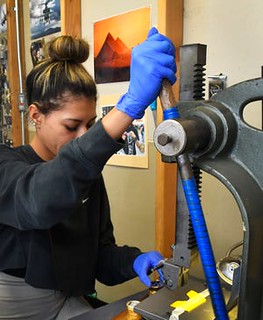 When the NFC Championship game ended at about 10 p.m. on Jan. 30, most people likely went to bed or took to social media to share their thoughts on the upcoming Rams-Bengals Super Bowl.
When the NFC Championship game ended at about 10 p.m. on Jan. 30, most people likely went to bed or took to social media to share their thoughts on the upcoming Rams-Bengals Super Bowl.
Not so for the workers of the Highland Mint.
As soon as Cincinnati and Los Angeles cemented their spots in the Super Bowl matchup, things began to crank up at the Melbourne-based facility that makes the official flip coin used before the start of the Super Bowl.
We go into production right after the game. We'll be here in the fourth quarter just getting ready,
said Vince Bohbot, executive vice president for the Highland Mint. The minting happens at 11 p.m. after the game because we already know the first orders that need to go out and we're shipping product out immediately first thing Monday morning. We'll have a crew that starts putting product together around 4 a.m. so by 4 p.m. we'll have a maximum number of goods leaving the facility.
It's a quick turnaround, but time is money.
The Highland Mint will make 10,000 flip coins, with Nos. 1-100 going to the NFL.
The first Super Bowl to use a Highland Mint coin was on Jan. 30, 1994, when Dallas faced Buffalo in Super Bowl XXVIII.
It begs the question: What was the NFL using before the Highland Mint began providing coins?
Nobody knew what they used for the flip coin, they used quarters or whoever had whatever in their pockets,
Bohbot said. They decided to make it very exclusive and special and so now it's become such a big part of the pregame ceremony.
To read the complete article, see:
You can bet on it. Super Bowl coin minted in Melbourne will take center stage Feb. 13
(https://www.floridatoday.com/story/news/2022/02/08/heads-tails-highland-mints-super-bowl-flip-coin-has-big-impact/6662370001/)
For background on the company, see this 2016 Bloomberg Businessweek article involving James Meadlock, Irving and Mark Kott, Mark Cuban, the FBI and The Wolf of Wall Street. -Editor
To read the complete article, see:
The Super Bowl Coin Toss Has a Dark Secret
(https://www.bloomberg.com/features/2016-super-bowl-coin-toss/)
LOOSE CHANGE: FEBRUARY 13, 2022
Here are some additional items in the media this week that may be of interest. -Editor
A Stack's Bowers blog article by Dave Bowers examines the curious 1817 Cent with 15 stars. -Editor
Perhaps my very favorite cent among those of the 1816 to 1857 years is the 1817 with 15 obverse stars. Designated as N-16, this curious coin defies explanation. Elsewhere in numismatics we have the 1828 half cent and 1832 half eagle with 12 instead of the correct 13 stars, but the 1817 N-16 is off by two in its star count. Why?
To read the complete article, see:
The Curious 1817 Cent with 15 Stars
(https://www.stacksbowers.com/News/Pages/Blogs.aspx?ArticleID=the-1817-large-cent-15-stars)
Paul Horner and Rich Bottles, Jr. passed along articles about the Home Depot employee's counterfeit cash. -Editor
A Tempe, Arizona, Home Depot employee is facing a federal charge, after authorities said he repeatedly took cash from the store and replaced it with counterfeit currency before depositing it in the bank, according to a criminal complaint.
According to a US Secret Service news release, agents from the Phoenix field office arrested Adrian Jean Pineda, a vault employee at the store, who was responsible for counting cash and preparing it for deposit. Pineda is accused of ordering counterfeit bills from Amazon, swapping them with money taken from store cash registers and sealing them in bags for transfer to the bank, according to the complaint. Pineda, the complaint said, admitted to switching the real money with fake bills in an interview with Secret Service agents.
To read the complete articles, see:
Home Depot employee arrested for swapping store cash with counterfeit bills for years, authorities say
(https://www.cnn.com/2022/02/04/us/home-depot-counterfeit-arrest/index.html)
The Secret Service says a Home Depot employee admitted to swapping $387,500 in cash with pretend $100 bills marked 'PLAYMONEY' that he bought off Amazon
(https://news.yahoo.com/secret-says-home-depot-employee-165344704.html)
Coins get counterfeited, too. Here's a recent Numismatic News article by Rich Giedroyc. -Editor
Outside of Japan's 500-yen coin, which has significant purchasing power, you don't hear much of anything anymore about counterfeit coins. Counterfeiting circulating coins appears to be something out of the past since the financial gains are typically more significant should someone choose to counterfeit bank notes or simply go into theft of cyber currencies instead.
Apparently while counterfeiting coins may be primarily off the radar the business
is still prospering. The Financial Crimes Unit of the Israel Police's 443 Major Crimes Unit will attest to that. On Dec. 8 it was announced four suspects were arrested a day earlier. The individuals have been accused of counterfeiting Israeli 5- and 10-shekel coins.
To read the complete article, see:
Coin Counterfeiting Making Headlines
(https://www.numismaticnews.net/world-coins/coin-counterfeiting-making-headlines)
GLUE AND THE ART OF NUMISMATIC REPAIRS
In the krazy-koin-konservation department is this thread from the Coin Talk forum about fixing broken wooden nickels. -Editor
User paddyman98 writes:
"I recently received this Wooden Dollar in the mail by member @dwhiz .. Unfortunately it was damaged in the process of it reaching me. It broke into 3 separate pieces.
"But I found the quick fix.. Krazy Glue! Just a tiny dab and it is whole again."
User Dave Waterstraast writes:
"A very rare wooden planchet crack creating a scar face..."
User alurid writes:
"I prefer Elmer's wood glue myself as it does not stain."
User johnmilton writes:
"Believe it or not, there is stuff called museum glue that is used to hold coins together. I have most often seen it used for English pennies of Matilda. She was the daughter of King Henry I. She had a legitimate claim to the English throne, but the nobles would not accept a woman as their queen and sole leader.
She and her supporters fought an unsuccessful civil war to gain power. During that war, she issued poorly made pennies that are quite rare today. They are fragile and often break apart. Hence glue is used to hold them together. "
I located an article online about the coins of Matilda and reached out to dealer Allan Davisson on the issue of "museum glue". Thanks! -Editor
To read the complete article, see:
Coins of the English Anarchy
1138-1153
(http://www.faintich.net/Coins_of_the_Anarchy.htm)
Allan writes:
"It's a pretty comprehensive article on that period—I have nothing to add. He has covered it well.
"I have handled a piece (possibly two—I've been at this a while). I do recall the repair. The repair on the one I handled a decade or so ago had been made with what looked like epoxy. It's tricky to work with and I have used it carefully on a small number of pieces. But the Matilda piece I handled had already been repaired. Between ground damage and the low quality of the silver damage is common with these.
"There was an illegally offered group on the market a few years ago. The finders had been trespassing and tried to evade British law. They offered bits and pieces but ended up getting caught. I think you covered this in an edition of The E-Sylum.
"I can't help with the specific term museum glue
but I see when I google the term that there are a fair number of products offered that use the term."
To read the complete discussion, see:
How to fix a coin broken in 3 parts - Krazy Glue!
(https://www.cointalk.com/threads/how-to-fix-a-coin-broken-in-3-parts-krazy-glue.392354/)

